Strategic Management and Leadership in AirAsia
VerifiedAdded on 2023/06/05
|26
|6136
|231
AI Summary
This article discusses the strategic management and leadership in AirAsia, including its value chain analysis, core competencies, and reasons for success. It also covers the challenges faced by the company and its future prospects. The article is relevant for students studying strategic management and leadership in the airline industry. Course code and college/university are not mentioned.
Contribute Materials
Your contribution can guide someone’s learning journey. Share your
documents today.

Running head: STRATEGIC MANAGEMENT AND LEADERSHIP
Strategic Management and Leadership
Student’s name:
University of the student:
Author’s note:
Strategic Management and Leadership
Student’s name:
University of the student:
Author’s note:
Secure Best Marks with AI Grader
Need help grading? Try our AI Grader for instant feedback on your assignments.
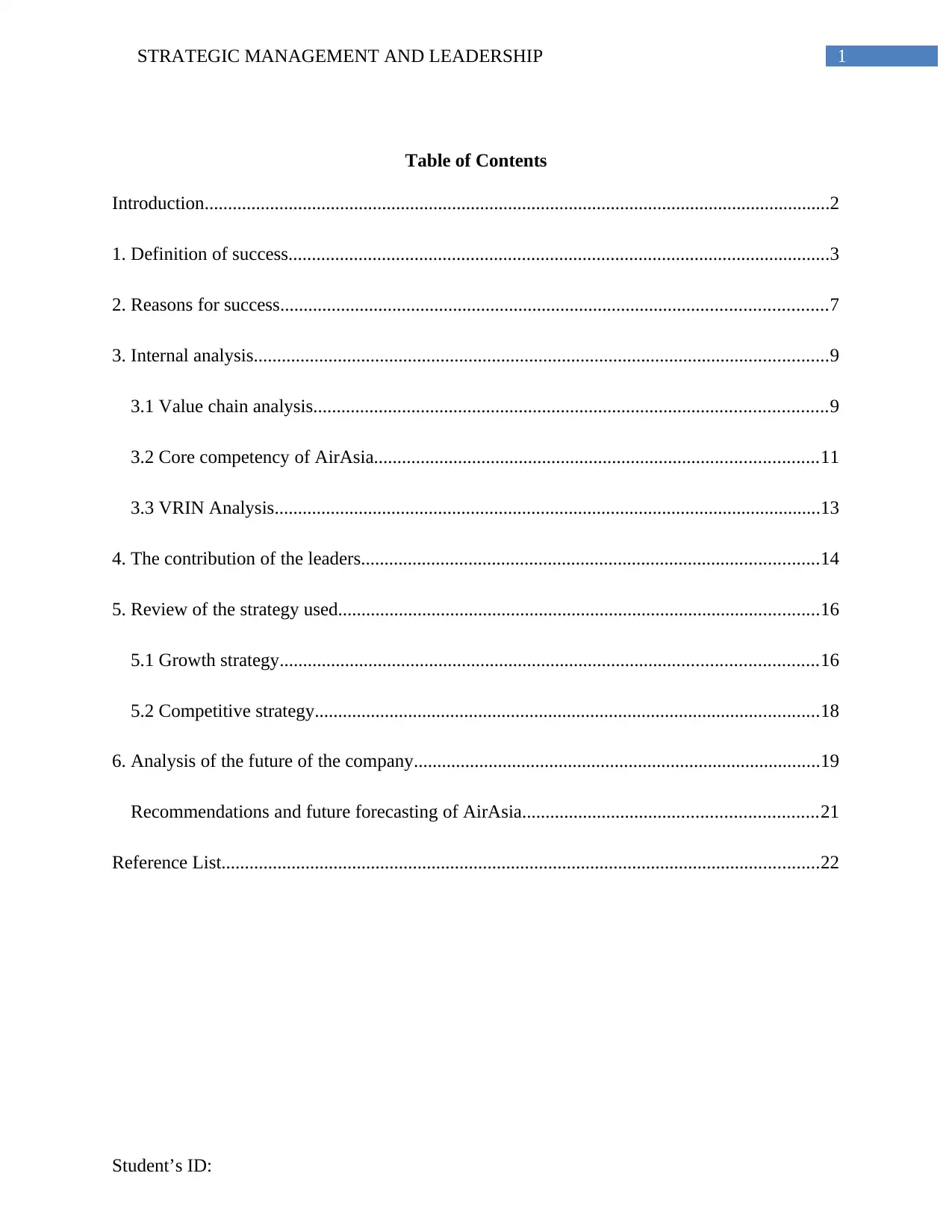
1STRATEGIC MANAGEMENT AND LEADERSHIP
Table of Contents
Introduction......................................................................................................................................2
1. Definition of success....................................................................................................................3
2. Reasons for success.....................................................................................................................7
3. Internal analysis...........................................................................................................................9
3.1 Value chain analysis..............................................................................................................9
3.2 Core competency of AirAsia...............................................................................................11
3.3 VRIN Analysis.....................................................................................................................13
4. The contribution of the leaders..................................................................................................14
5. Review of the strategy used.......................................................................................................16
5.1 Growth strategy...................................................................................................................16
5.2 Competitive strategy............................................................................................................18
6. Analysis of the future of the company.......................................................................................19
Recommendations and future forecasting of AirAsia...............................................................21
Reference List................................................................................................................................22
Student’s ID:
Table of Contents
Introduction......................................................................................................................................2
1. Definition of success....................................................................................................................3
2. Reasons for success.....................................................................................................................7
3. Internal analysis...........................................................................................................................9
3.1 Value chain analysis..............................................................................................................9
3.2 Core competency of AirAsia...............................................................................................11
3.3 VRIN Analysis.....................................................................................................................13
4. The contribution of the leaders..................................................................................................14
5. Review of the strategy used.......................................................................................................16
5.1 Growth strategy...................................................................................................................16
5.2 Competitive strategy............................................................................................................18
6. Analysis of the future of the company.......................................................................................19
Recommendations and future forecasting of AirAsia...............................................................21
Reference List................................................................................................................................22
Student’s ID:
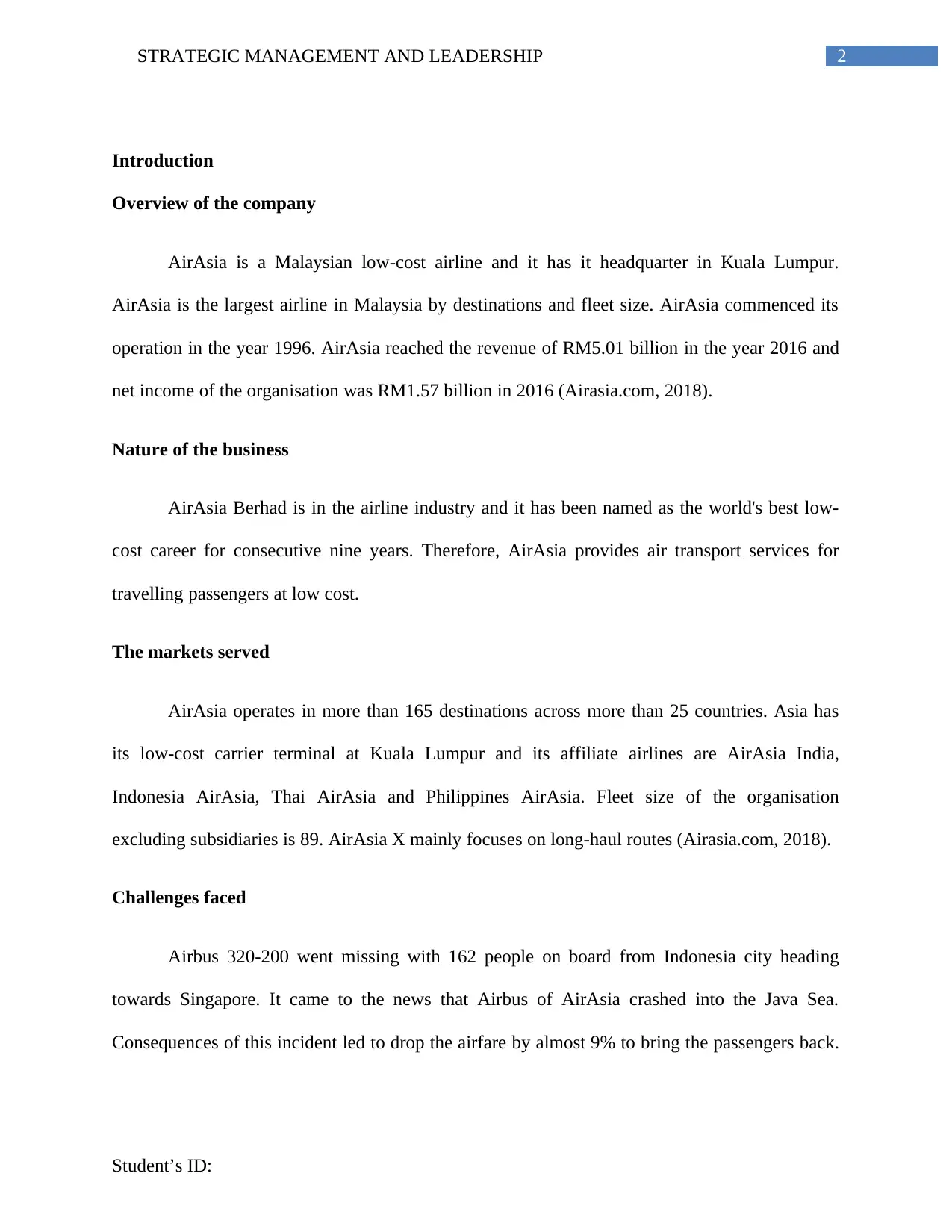
2STRATEGIC MANAGEMENT AND LEADERSHIP
Introduction
Overview of the company
AirAsia is a Malaysian low-cost airline and it has it headquarter in Kuala Lumpur.
AirAsia is the largest airline in Malaysia by destinations and fleet size. AirAsia commenced its
operation in the year 1996. AirAsia reached the revenue of RM5.01 billion in the year 2016 and
net income of the organisation was RM1.57 billion in 2016 (Airasia.com, 2018).
Nature of the business
AirAsia Berhad is in the airline industry and it has been named as the world's best low-
cost career for consecutive nine years. Therefore, AirAsia provides air transport services for
travelling passengers at low cost.
The markets served
AirAsia operates in more than 165 destinations across more than 25 countries. Asia has
its low-cost carrier terminal at Kuala Lumpur and its affiliate airlines are AirAsia India,
Indonesia AirAsia, Thai AirAsia and Philippines AirAsia. Fleet size of the organisation
excluding subsidiaries is 89. AirAsia X mainly focuses on long-haul routes (Airasia.com, 2018).
Challenges faced
Airbus 320-200 went missing with 162 people on board from Indonesia city heading
towards Singapore. It came to the news that Airbus of AirAsia crashed into the Java Sea.
Consequences of this incident led to drop the airfare by almost 9% to bring the passengers back.
Student’s ID:
Introduction
Overview of the company
AirAsia is a Malaysian low-cost airline and it has it headquarter in Kuala Lumpur.
AirAsia is the largest airline in Malaysia by destinations and fleet size. AirAsia commenced its
operation in the year 1996. AirAsia reached the revenue of RM5.01 billion in the year 2016 and
net income of the organisation was RM1.57 billion in 2016 (Airasia.com, 2018).
Nature of the business
AirAsia Berhad is in the airline industry and it has been named as the world's best low-
cost career for consecutive nine years. Therefore, AirAsia provides air transport services for
travelling passengers at low cost.
The markets served
AirAsia operates in more than 165 destinations across more than 25 countries. Asia has
its low-cost carrier terminal at Kuala Lumpur and its affiliate airlines are AirAsia India,
Indonesia AirAsia, Thai AirAsia and Philippines AirAsia. Fleet size of the organisation
excluding subsidiaries is 89. AirAsia X mainly focuses on long-haul routes (Airasia.com, 2018).
Challenges faced
Airbus 320-200 went missing with 162 people on board from Indonesia city heading
towards Singapore. It came to the news that Airbus of AirAsia crashed into the Java Sea.
Consequences of this incident led to drop the airfare by almost 9% to bring the passengers back.
Student’s ID:
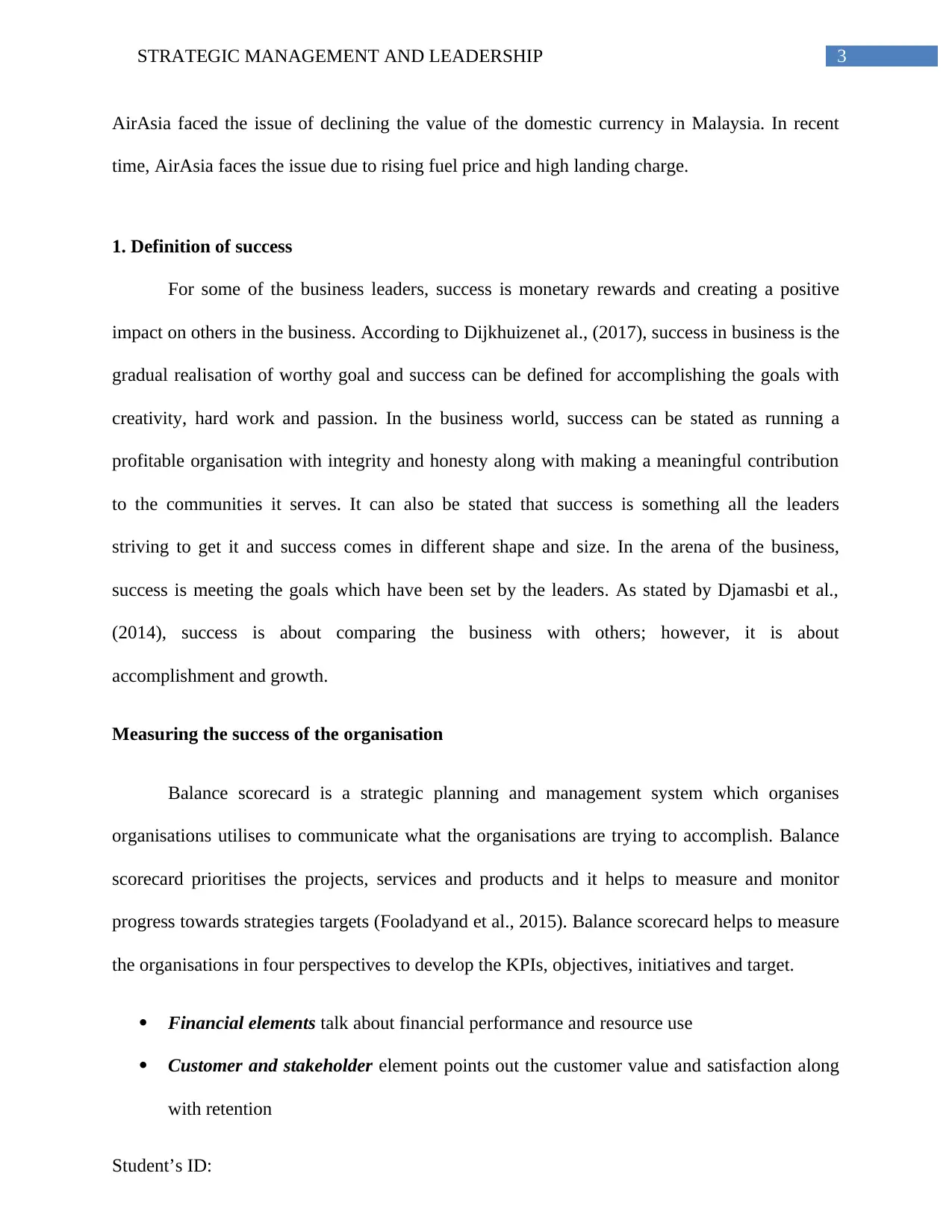
3STRATEGIC MANAGEMENT AND LEADERSHIP
AirAsia faced the issue of declining the value of the domestic currency in Malaysia. In recent
time, AirAsia faces the issue due to rising fuel price and high landing charge.
1. Definition of success
For some of the business leaders, success is monetary rewards and creating a positive
impact on others in the business. According to Dijkhuizenet al., (2017), success in business is the
gradual realisation of worthy goal and success can be defined for accomplishing the goals with
creativity, hard work and passion. In the business world, success can be stated as running a
profitable organisation with integrity and honesty along with making a meaningful contribution
to the communities it serves. It can also be stated that success is something all the leaders
striving to get it and success comes in different shape and size. In the arena of the business,
success is meeting the goals which have been set by the leaders. As stated by Djamasbi et al.,
(2014), success is about comparing the business with others; however, it is about
accomplishment and growth.
Measuring the success of the organisation
Balance scorecard is a strategic planning and management system which organises
organisations utilises to communicate what the organisations are trying to accomplish. Balance
scorecard prioritises the projects, services and products and it helps to measure and monitor
progress towards strategies targets (Fooladyand et al., 2015). Balance scorecard helps to measure
the organisations in four perspectives to develop the KPIs, objectives, initiatives and target.
Financial elements talk about financial performance and resource use
Customer and stakeholder element points out the customer value and satisfaction along
with retention
Student’s ID:
AirAsia faced the issue of declining the value of the domestic currency in Malaysia. In recent
time, AirAsia faces the issue due to rising fuel price and high landing charge.
1. Definition of success
For some of the business leaders, success is monetary rewards and creating a positive
impact on others in the business. According to Dijkhuizenet al., (2017), success in business is the
gradual realisation of worthy goal and success can be defined for accomplishing the goals with
creativity, hard work and passion. In the business world, success can be stated as running a
profitable organisation with integrity and honesty along with making a meaningful contribution
to the communities it serves. It can also be stated that success is something all the leaders
striving to get it and success comes in different shape and size. In the arena of the business,
success is meeting the goals which have been set by the leaders. As stated by Djamasbi et al.,
(2014), success is about comparing the business with others; however, it is about
accomplishment and growth.
Measuring the success of the organisation
Balance scorecard is a strategic planning and management system which organises
organisations utilises to communicate what the organisations are trying to accomplish. Balance
scorecard prioritises the projects, services and products and it helps to measure and monitor
progress towards strategies targets (Fooladyand et al., 2015). Balance scorecard helps to measure
the organisations in four perspectives to develop the KPIs, objectives, initiatives and target.
Financial elements talk about financial performance and resource use
Customer and stakeholder element points out the customer value and satisfaction along
with retention
Student’s ID:
Secure Best Marks with AI Grader
Need help grading? Try our AI Grader for instant feedback on your assignments.
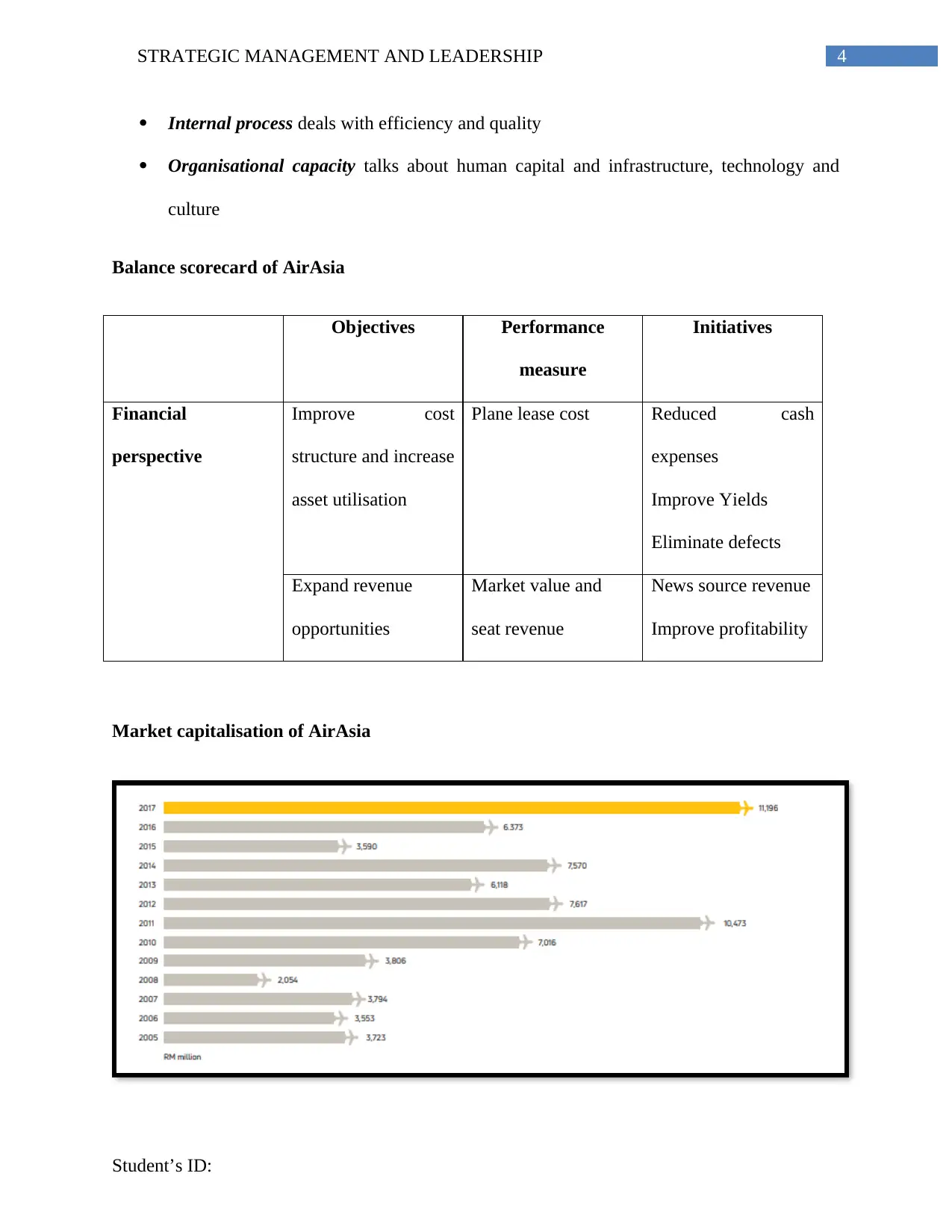
4STRATEGIC MANAGEMENT AND LEADERSHIP
Internal process deals with efficiency and quality
Organisational capacity talks about human capital and infrastructure, technology and
culture
Balance scorecard of AirAsia
Objectives Performance
measure
Initiatives
Financial
perspective
Improve cost
structure and increase
asset utilisation
Plane lease cost Reduced cash
expenses
Improve Yields
Eliminate defects
Expand revenue
opportunities
Market value and
seat revenue
News source revenue
Improve profitability
Market capitalisation of AirAsia
Student’s ID:
Internal process deals with efficiency and quality
Organisational capacity talks about human capital and infrastructure, technology and
culture
Balance scorecard of AirAsia
Objectives Performance
measure
Initiatives
Financial
perspective
Improve cost
structure and increase
asset utilisation
Plane lease cost Reduced cash
expenses
Improve Yields
Eliminate defects
Expand revenue
opportunities
Market value and
seat revenue
News source revenue
Improve profitability
Market capitalisation of AirAsia
Student’s ID:
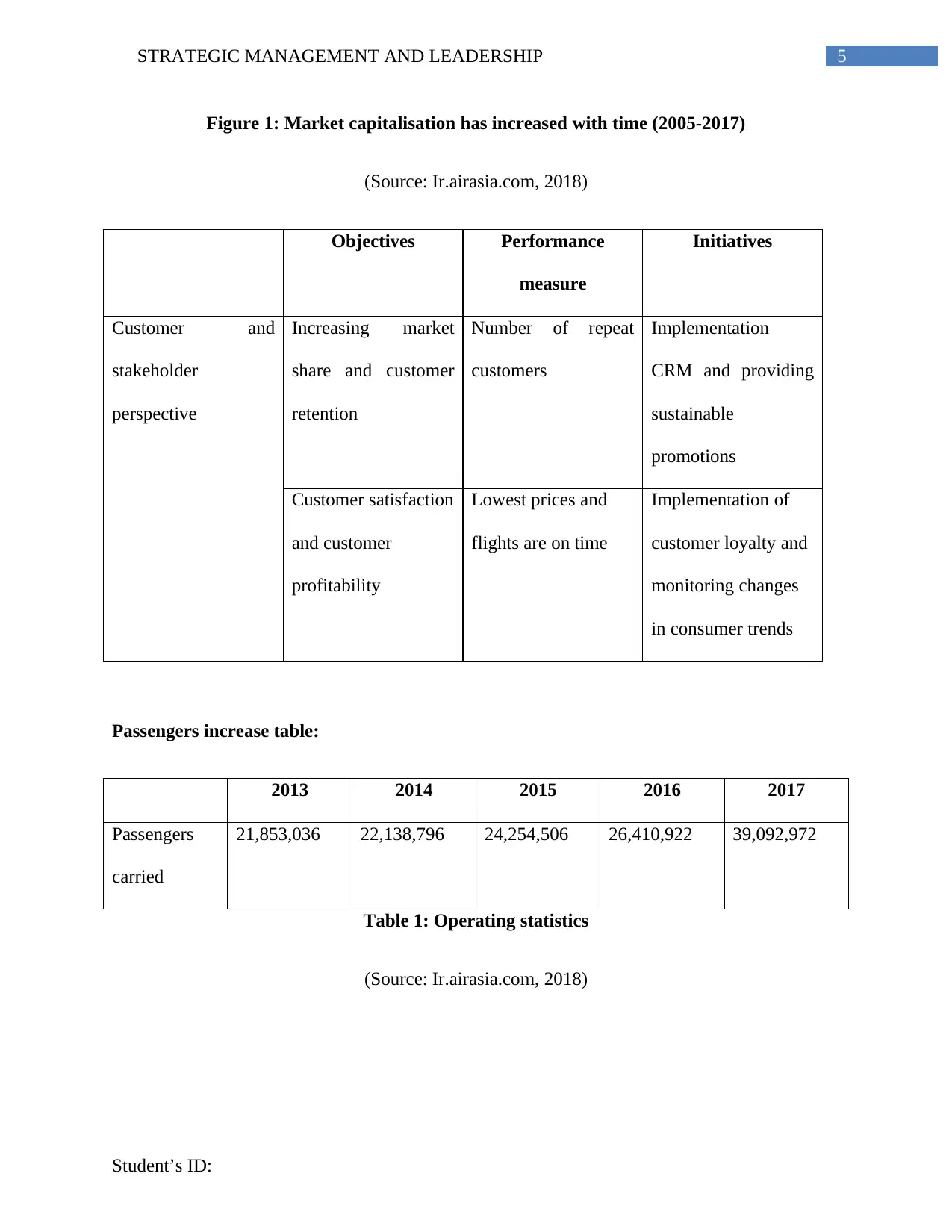
5STRATEGIC MANAGEMENT AND LEADERSHIP
Figure 1: Market capitalisation has increased with time (2005-2017)
(Source: Ir.airasia.com, 2018)
Objectives Performance
measure
Initiatives
Customer and
stakeholder
perspective
Increasing market
share and customer
retention
Number of repeat
customers
Implementation
CRM and providing
sustainable
promotions
Customer satisfaction
and customer
profitability
Lowest prices and
flights are on time
Implementation of
customer loyalty and
monitoring changes
in consumer trends
Passengers increase table:
2013 2014 2015 2016 2017
Passengers
carried
21,853,036 22,138,796 24,254,506 26,410,922 39,092,972
Table 1: Operating statistics
(Source: Ir.airasia.com, 2018)
Student’s ID:
Figure 1: Market capitalisation has increased with time (2005-2017)
(Source: Ir.airasia.com, 2018)
Objectives Performance
measure
Initiatives
Customer and
stakeholder
perspective
Increasing market
share and customer
retention
Number of repeat
customers
Implementation
CRM and providing
sustainable
promotions
Customer satisfaction
and customer
profitability
Lowest prices and
flights are on time
Implementation of
customer loyalty and
monitoring changes
in consumer trends
Passengers increase table:
2013 2014 2015 2016 2017
Passengers
carried
21,853,036 22,138,796 24,254,506 26,410,922 39,092,972
Table 1: Operating statistics
(Source: Ir.airasia.com, 2018)
Student’s ID:
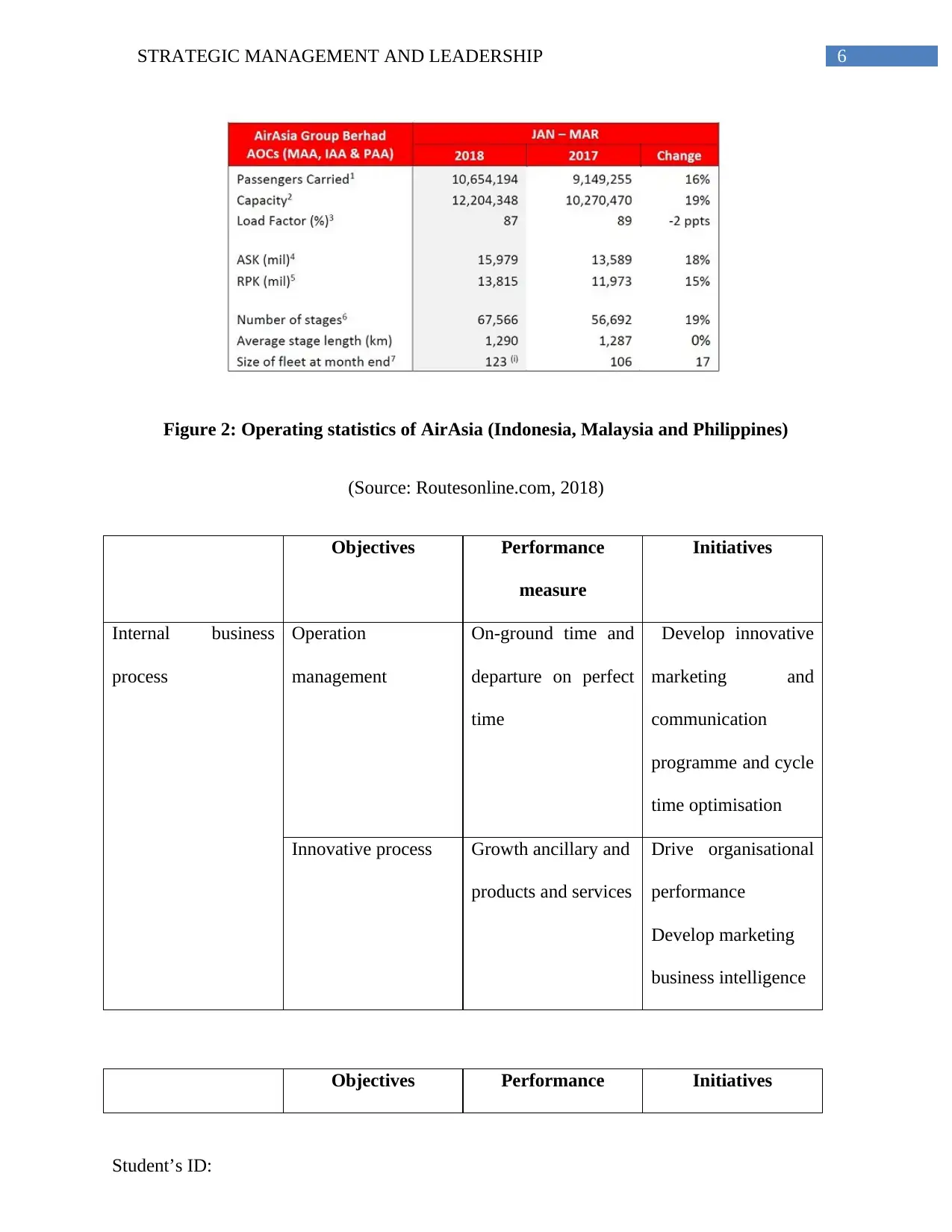
6STRATEGIC MANAGEMENT AND LEADERSHIP
Figure 2: Operating statistics of AirAsia (Indonesia, Malaysia and Philippines)
(Source: Routesonline.com, 2018)
Objectives Performance
measure
Initiatives
Internal business
process
Operation
management
On-ground time and
departure on perfect
time
Develop innovative
marketing and
communication
programme and cycle
time optimisation
Innovative process Growth ancillary and
products and services
Drive organisational
performance
Develop marketing
business intelligence
Objectives Performance Initiatives
Student’s ID:
Figure 2: Operating statistics of AirAsia (Indonesia, Malaysia and Philippines)
(Source: Routesonline.com, 2018)
Objectives Performance
measure
Initiatives
Internal business
process
Operation
management
On-ground time and
departure on perfect
time
Develop innovative
marketing and
communication
programme and cycle
time optimisation
Innovative process Growth ancillary and
products and services
Drive organisational
performance
Develop marketing
business intelligence
Objectives Performance Initiatives
Student’s ID:
Paraphrase This Document
Need a fresh take? Get an instant paraphrase of this document with our AI Paraphraser
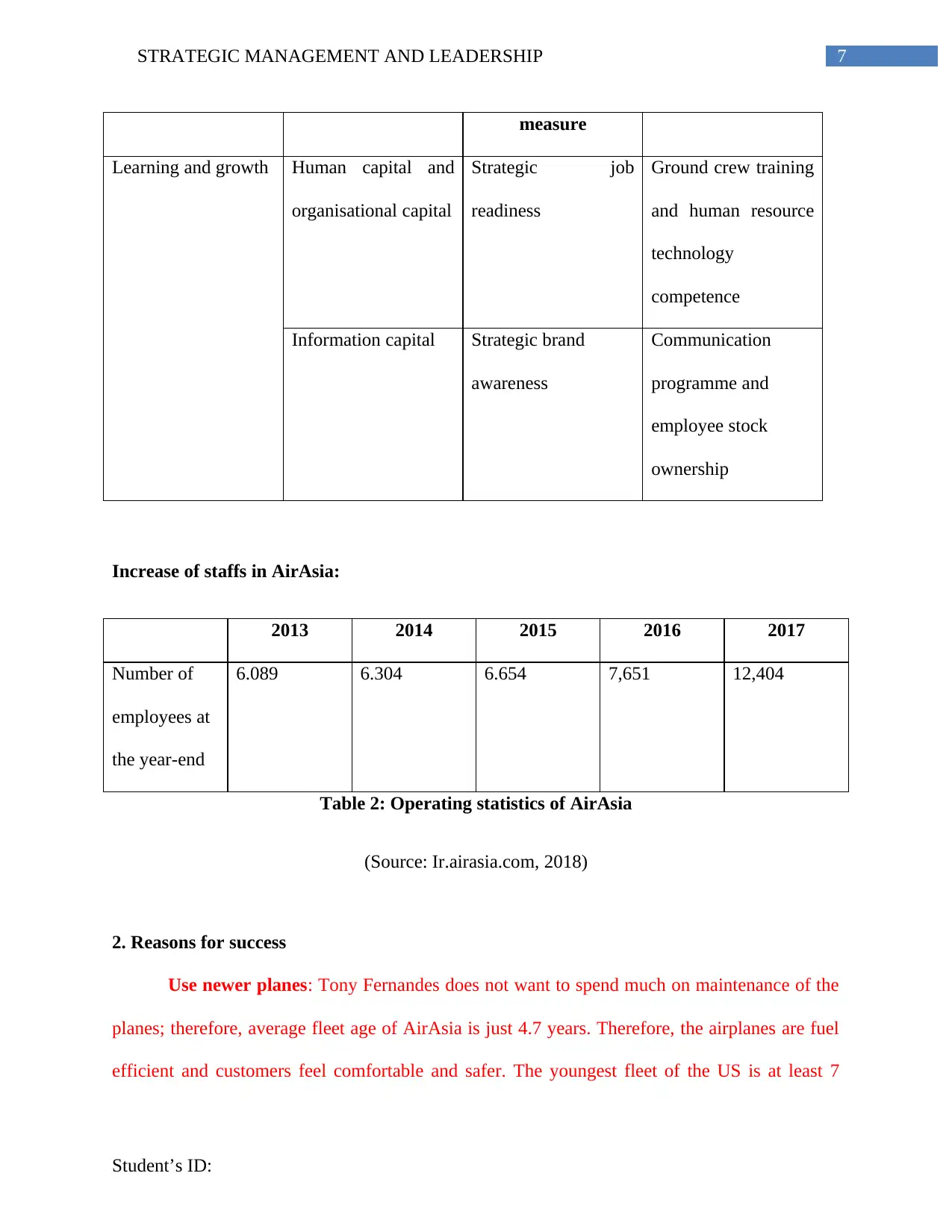
7STRATEGIC MANAGEMENT AND LEADERSHIP
measure
Learning and growth Human capital and
organisational capital
Strategic job
readiness
Ground crew training
and human resource
technology
competence
Information capital Strategic brand
awareness
Communication
programme and
employee stock
ownership
Increase of staffs in AirAsia:
2013 2014 2015 2016 2017
Number of
employees at
the year-end
6.089 6.304 6.654 7,651 12,404
Table 2: Operating statistics of AirAsia
(Source: Ir.airasia.com, 2018)
2. Reasons for success
Use newer planes: Tony Fernandes does not want to spend much on maintenance of the
planes; therefore, average fleet age of AirAsia is just 4.7 years. Therefore, the airplanes are fuel
efficient and customers feel comfortable and safer. The youngest fleet of the US is at least 7
Student’s ID:
measure
Learning and growth Human capital and
organisational capital
Strategic job
readiness
Ground crew training
and human resource
technology
competence
Information capital Strategic brand
awareness
Communication
programme and
employee stock
ownership
Increase of staffs in AirAsia:
2013 2014 2015 2016 2017
Number of
employees at
the year-end
6.089 6.304 6.654 7,651 12,404
Table 2: Operating statistics of AirAsia
(Source: Ir.airasia.com, 2018)
2. Reasons for success
Use newer planes: Tony Fernandes does not want to spend much on maintenance of the
planes; therefore, average fleet age of AirAsia is just 4.7 years. Therefore, the airplanes are fuel
efficient and customers feel comfortable and safer. The youngest fleet of the US is at least 7
Student’s ID:
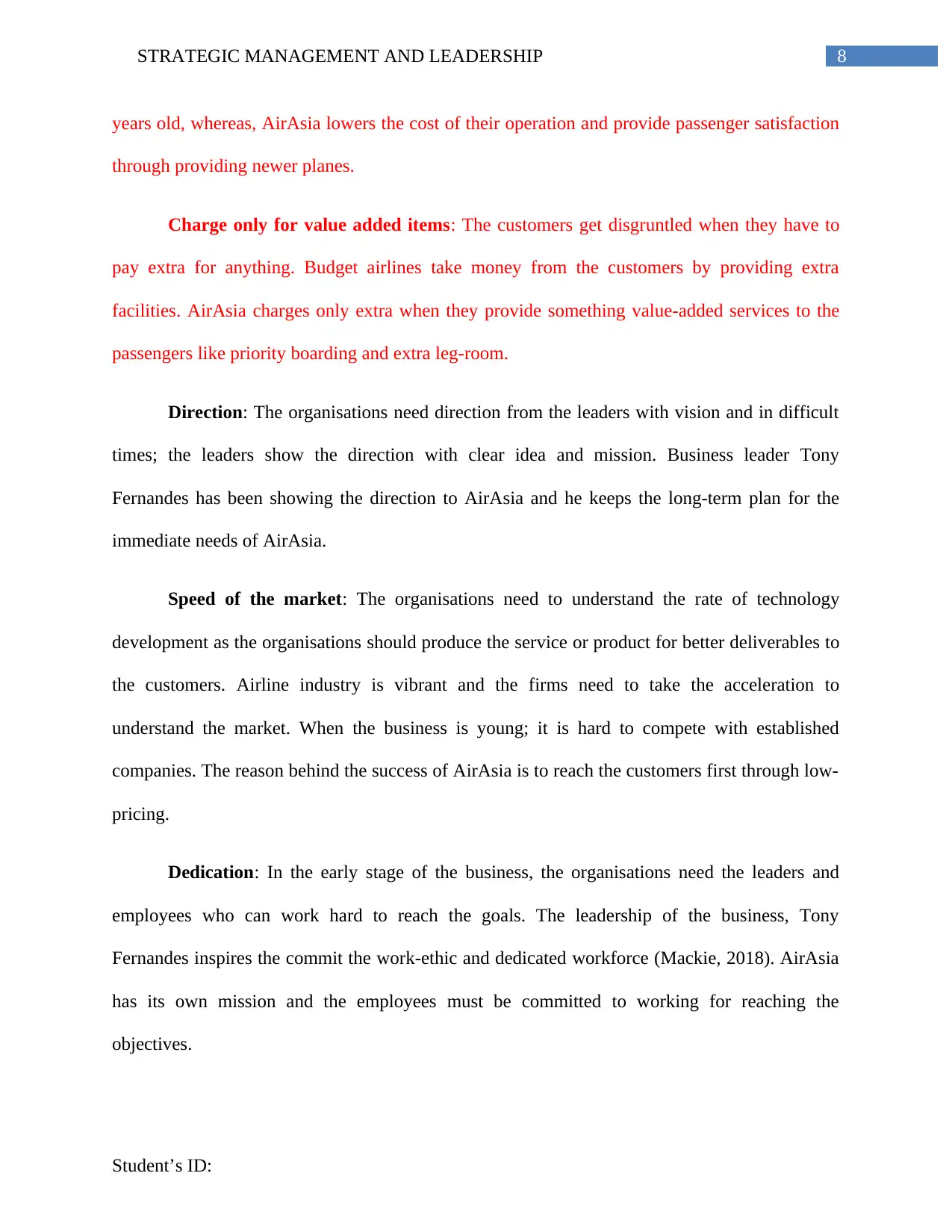
8STRATEGIC MANAGEMENT AND LEADERSHIP
years old, whereas, AirAsia lowers the cost of their operation and provide passenger satisfaction
through providing newer planes.
Charge only for value added items: The customers get disgruntled when they have to
pay extra for anything. Budget airlines take money from the customers by providing extra
facilities. AirAsia charges only extra when they provide something value-added services to the
passengers like priority boarding and extra leg-room.
Direction: The organisations need direction from the leaders with vision and in difficult
times; the leaders show the direction with clear idea and mission. Business leader Tony
Fernandes has been showing the direction to AirAsia and he keeps the long-term plan for the
immediate needs of AirAsia.
Speed of the market: The organisations need to understand the rate of technology
development as the organisations should produce the service or product for better deliverables to
the customers. Airline industry is vibrant and the firms need to take the acceleration to
understand the market. When the business is young; it is hard to compete with established
companies. The reason behind the success of AirAsia is to reach the customers first through low-
pricing.
Dedication: In the early stage of the business, the organisations need the leaders and
employees who can work hard to reach the goals. The leadership of the business, Tony
Fernandes inspires the commit the work-ethic and dedicated workforce (Mackie, 2018). AirAsia
has its own mission and the employees must be committed to working for reaching the
objectives.
Student’s ID:
years old, whereas, AirAsia lowers the cost of their operation and provide passenger satisfaction
through providing newer planes.
Charge only for value added items: The customers get disgruntled when they have to
pay extra for anything. Budget airlines take money from the customers by providing extra
facilities. AirAsia charges only extra when they provide something value-added services to the
passengers like priority boarding and extra leg-room.
Direction: The organisations need direction from the leaders with vision and in difficult
times; the leaders show the direction with clear idea and mission. Business leader Tony
Fernandes has been showing the direction to AirAsia and he keeps the long-term plan for the
immediate needs of AirAsia.
Speed of the market: The organisations need to understand the rate of technology
development as the organisations should produce the service or product for better deliverables to
the customers. Airline industry is vibrant and the firms need to take the acceleration to
understand the market. When the business is young; it is hard to compete with established
companies. The reason behind the success of AirAsia is to reach the customers first through low-
pricing.
Dedication: In the early stage of the business, the organisations need the leaders and
employees who can work hard to reach the goals. The leadership of the business, Tony
Fernandes inspires the commit the work-ethic and dedicated workforce (Mackie, 2018). AirAsia
has its own mission and the employees must be committed to working for reaching the
objectives.
Student’s ID:
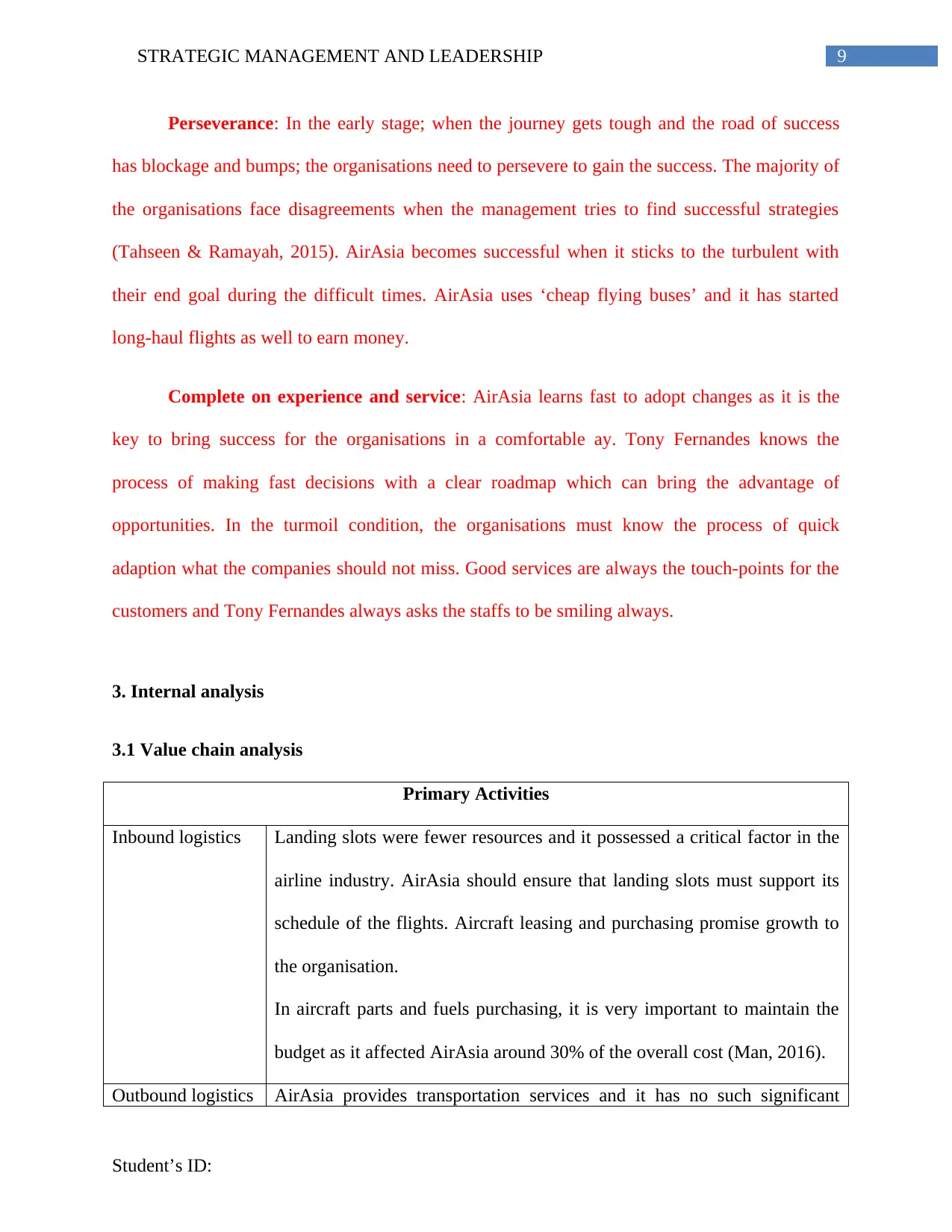
9STRATEGIC MANAGEMENT AND LEADERSHIP
Perseverance: In the early stage; when the journey gets tough and the road of success
has blockage and bumps; the organisations need to persevere to gain the success. The majority of
the organisations face disagreements when the management tries to find successful strategies
(Tahseen & Ramayah, 2015). AirAsia becomes successful when it sticks to the turbulent with
their end goal during the difficult times. AirAsia uses ‘cheap flying buses’ and it has started
long-haul flights as well to earn money.
Complete on experience and service: AirAsia learns fast to adopt changes as it is the
key to bring success for the organisations in a comfortable ay. Tony Fernandes knows the
process of making fast decisions with a clear roadmap which can bring the advantage of
opportunities. In the turmoil condition, the organisations must know the process of quick
adaption what the companies should not miss. Good services are always the touch-points for the
customers and Tony Fernandes always asks the staffs to be smiling always.
3. Internal analysis
3.1 Value chain analysis
Primary Activities
Inbound logistics Landing slots were fewer resources and it possessed a critical factor in the
airline industry. AirAsia should ensure that landing slots must support its
schedule of the flights. Aircraft leasing and purchasing promise growth to
the organisation.
In aircraft parts and fuels purchasing, it is very important to maintain the
budget as it affected AirAsia around 30% of the overall cost (Man, 2016).
Outbound logistics AirAsia provides transportation services and it has no such significant
Student’s ID:
Perseverance: In the early stage; when the journey gets tough and the road of success
has blockage and bumps; the organisations need to persevere to gain the success. The majority of
the organisations face disagreements when the management tries to find successful strategies
(Tahseen & Ramayah, 2015). AirAsia becomes successful when it sticks to the turbulent with
their end goal during the difficult times. AirAsia uses ‘cheap flying buses’ and it has started
long-haul flights as well to earn money.
Complete on experience and service: AirAsia learns fast to adopt changes as it is the
key to bring success for the organisations in a comfortable ay. Tony Fernandes knows the
process of making fast decisions with a clear roadmap which can bring the advantage of
opportunities. In the turmoil condition, the organisations must know the process of quick
adaption what the companies should not miss. Good services are always the touch-points for the
customers and Tony Fernandes always asks the staffs to be smiling always.
3. Internal analysis
3.1 Value chain analysis
Primary Activities
Inbound logistics Landing slots were fewer resources and it possessed a critical factor in the
airline industry. AirAsia should ensure that landing slots must support its
schedule of the flights. Aircraft leasing and purchasing promise growth to
the organisation.
In aircraft parts and fuels purchasing, it is very important to maintain the
budget as it affected AirAsia around 30% of the overall cost (Man, 2016).
Outbound logistics AirAsia provides transportation services and it has no such significant
Student’s ID:
Secure Best Marks with AI Grader
Need help grading? Try our AI Grader for instant feedback on your assignments.
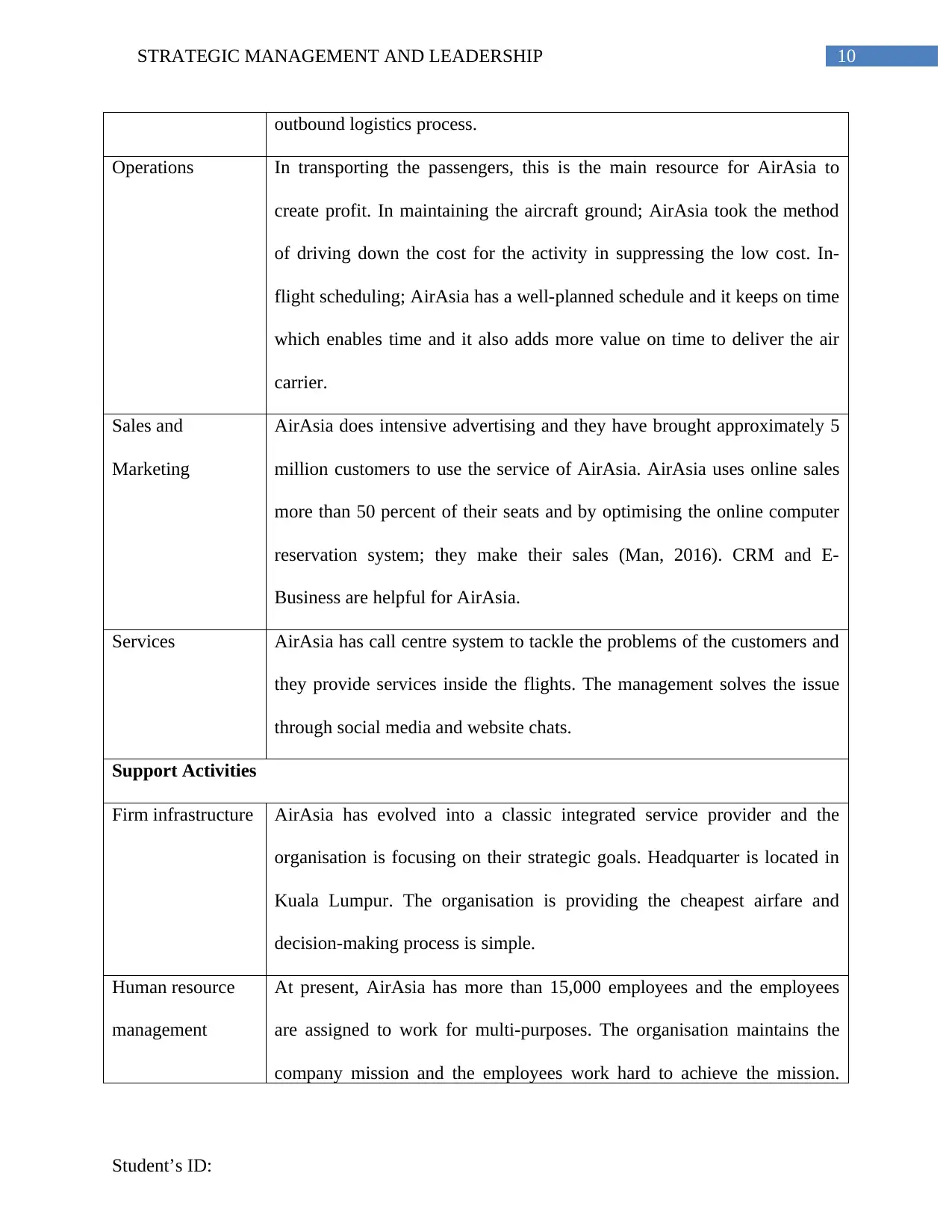
10STRATEGIC MANAGEMENT AND LEADERSHIP
outbound logistics process.
Operations In transporting the passengers, this is the main resource for AirAsia to
create profit. In maintaining the aircraft ground; AirAsia took the method
of driving down the cost for the activity in suppressing the low cost. In-
flight scheduling; AirAsia has a well-planned schedule and it keeps on time
which enables time and it also adds more value on time to deliver the air
carrier.
Sales and
Marketing
AirAsia does intensive advertising and they have brought approximately 5
million customers to use the service of AirAsia. AirAsia uses online sales
more than 50 percent of their seats and by optimising the online computer
reservation system; they make their sales (Man, 2016). CRM and E-
Business are helpful for AirAsia.
Services AirAsia has call centre system to tackle the problems of the customers and
they provide services inside the flights. The management solves the issue
through social media and website chats.
Support Activities
Firm infrastructure AirAsia has evolved into a classic integrated service provider and the
organisation is focusing on their strategic goals. Headquarter is located in
Kuala Lumpur. The organisation is providing the cheapest airfare and
decision-making process is simple.
Human resource
management
At present, AirAsia has more than 15,000 employees and the employees
are assigned to work for multi-purposes. The organisation maintains the
company mission and the employees work hard to achieve the mission.
Student’s ID:
outbound logistics process.
Operations In transporting the passengers, this is the main resource for AirAsia to
create profit. In maintaining the aircraft ground; AirAsia took the method
of driving down the cost for the activity in suppressing the low cost. In-
flight scheduling; AirAsia has a well-planned schedule and it keeps on time
which enables time and it also adds more value on time to deliver the air
carrier.
Sales and
Marketing
AirAsia does intensive advertising and they have brought approximately 5
million customers to use the service of AirAsia. AirAsia uses online sales
more than 50 percent of their seats and by optimising the online computer
reservation system; they make their sales (Man, 2016). CRM and E-
Business are helpful for AirAsia.
Services AirAsia has call centre system to tackle the problems of the customers and
they provide services inside the flights. The management solves the issue
through social media and website chats.
Support Activities
Firm infrastructure AirAsia has evolved into a classic integrated service provider and the
organisation is focusing on their strategic goals. Headquarter is located in
Kuala Lumpur. The organisation is providing the cheapest airfare and
decision-making process is simple.
Human resource
management
At present, AirAsia has more than 15,000 employees and the employees
are assigned to work for multi-purposes. The organisation maintains the
company mission and the employees work hard to achieve the mission.
Student’s ID:
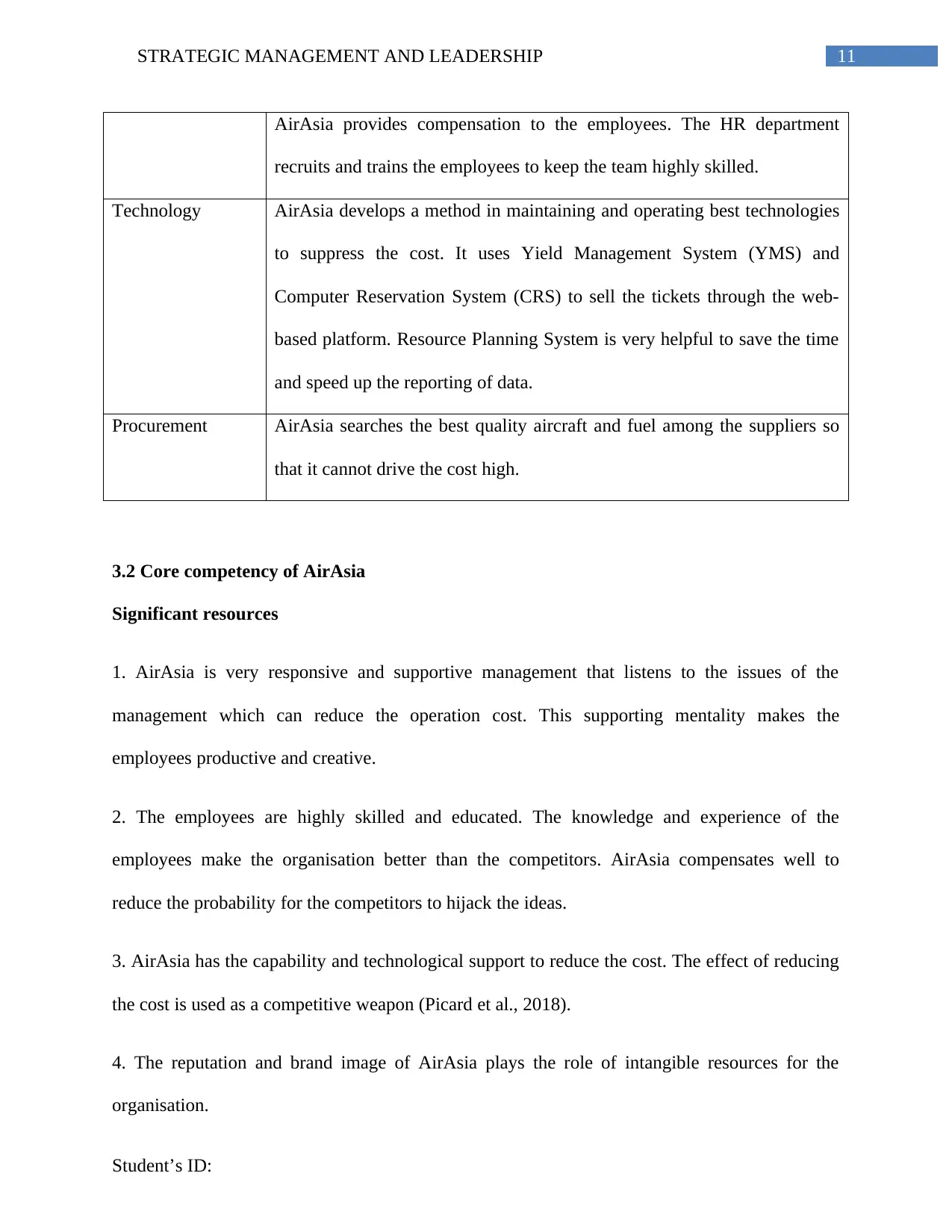
11STRATEGIC MANAGEMENT AND LEADERSHIP
AirAsia provides compensation to the employees. The HR department
recruits and trains the employees to keep the team highly skilled.
Technology AirAsia develops a method in maintaining and operating best technologies
to suppress the cost. It uses Yield Management System (YMS) and
Computer Reservation System (CRS) to sell the tickets through the web-
based platform. Resource Planning System is very helpful to save the time
and speed up the reporting of data.
Procurement AirAsia searches the best quality aircraft and fuel among the suppliers so
that it cannot drive the cost high.
3.2 Core competency of AirAsia
Significant resources
1. AirAsia is very responsive and supportive management that listens to the issues of the
management which can reduce the operation cost. This supporting mentality makes the
employees productive and creative.
2. The employees are highly skilled and educated. The knowledge and experience of the
employees make the organisation better than the competitors. AirAsia compensates well to
reduce the probability for the competitors to hijack the ideas.
3. AirAsia has the capability and technological support to reduce the cost. The effect of reducing
the cost is used as a competitive weapon (Picard et al., 2018).
4. The reputation and brand image of AirAsia plays the role of intangible resources for the
organisation.
Student’s ID:
AirAsia provides compensation to the employees. The HR department
recruits and trains the employees to keep the team highly skilled.
Technology AirAsia develops a method in maintaining and operating best technologies
to suppress the cost. It uses Yield Management System (YMS) and
Computer Reservation System (CRS) to sell the tickets through the web-
based platform. Resource Planning System is very helpful to save the time
and speed up the reporting of data.
Procurement AirAsia searches the best quality aircraft and fuel among the suppliers so
that it cannot drive the cost high.
3.2 Core competency of AirAsia
Significant resources
1. AirAsia is very responsive and supportive management that listens to the issues of the
management which can reduce the operation cost. This supporting mentality makes the
employees productive and creative.
2. The employees are highly skilled and educated. The knowledge and experience of the
employees make the organisation better than the competitors. AirAsia compensates well to
reduce the probability for the competitors to hijack the ideas.
3. AirAsia has the capability and technological support to reduce the cost. The effect of reducing
the cost is used as a competitive weapon (Picard et al., 2018).
4. The reputation and brand image of AirAsia plays the role of intangible resources for the
organisation.
Student’s ID:
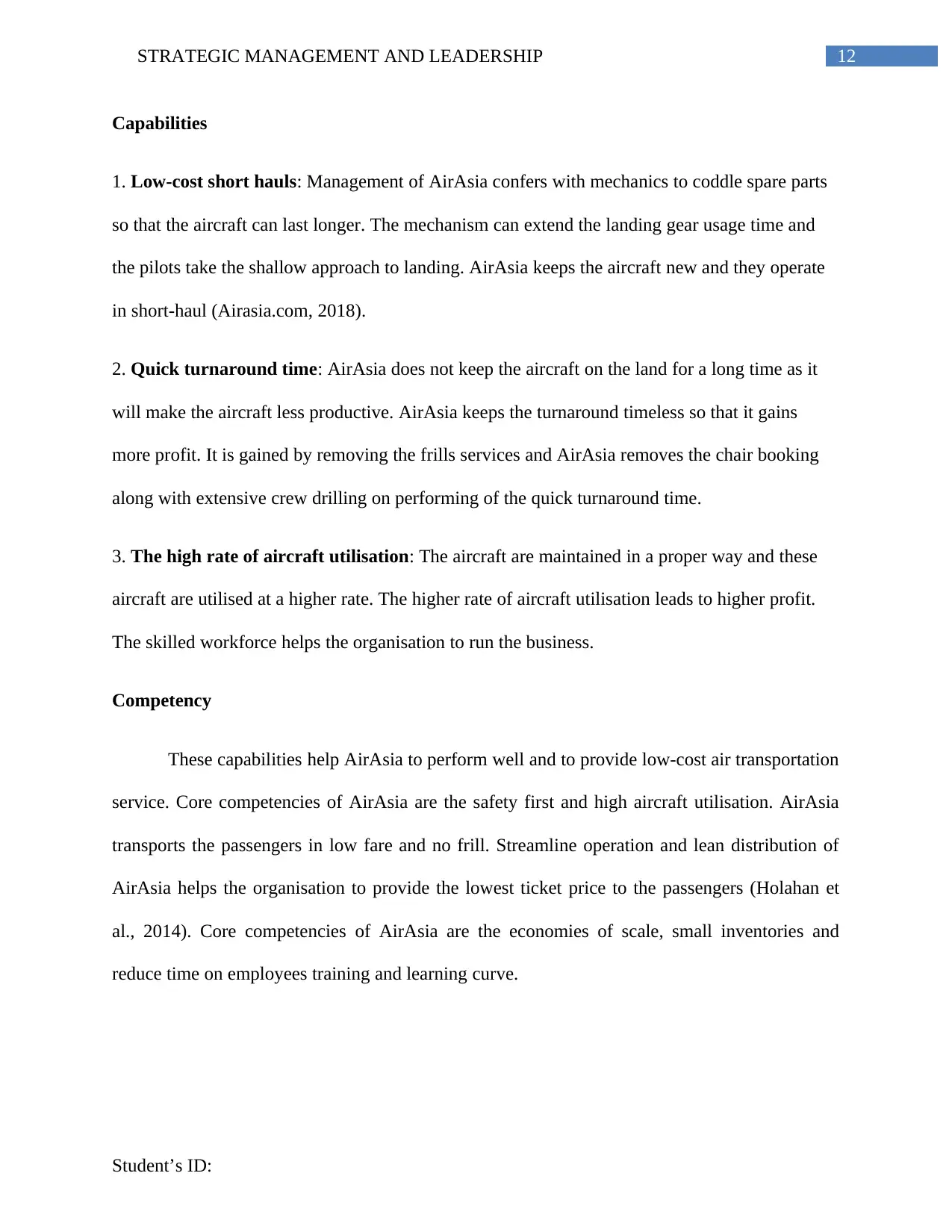
12STRATEGIC MANAGEMENT AND LEADERSHIP
Capabilities
1. Low-cost short hauls: Management of AirAsia confers with mechanics to coddle spare parts
so that the aircraft can last longer. The mechanism can extend the landing gear usage time and
the pilots take the shallow approach to landing. AirAsia keeps the aircraft new and they operate
in short-haul (Airasia.com, 2018).
2. Quick turnaround time: AirAsia does not keep the aircraft on the land for a long time as it
will make the aircraft less productive. AirAsia keeps the turnaround timeless so that it gains
more profit. It is gained by removing the frills services and AirAsia removes the chair booking
along with extensive crew drilling on performing of the quick turnaround time.
3. The high rate of aircraft utilisation: The aircraft are maintained in a proper way and these
aircraft are utilised at a higher rate. The higher rate of aircraft utilisation leads to higher profit.
The skilled workforce helps the organisation to run the business.
Competency
These capabilities help AirAsia to perform well and to provide low-cost air transportation
service. Core competencies of AirAsia are the safety first and high aircraft utilisation. AirAsia
transports the passengers in low fare and no frill. Streamline operation and lean distribution of
AirAsia helps the organisation to provide the lowest ticket price to the passengers (Holahan et
al., 2014). Core competencies of AirAsia are the economies of scale, small inventories and
reduce time on employees training and learning curve.
Student’s ID:
Capabilities
1. Low-cost short hauls: Management of AirAsia confers with mechanics to coddle spare parts
so that the aircraft can last longer. The mechanism can extend the landing gear usage time and
the pilots take the shallow approach to landing. AirAsia keeps the aircraft new and they operate
in short-haul (Airasia.com, 2018).
2. Quick turnaround time: AirAsia does not keep the aircraft on the land for a long time as it
will make the aircraft less productive. AirAsia keeps the turnaround timeless so that it gains
more profit. It is gained by removing the frills services and AirAsia removes the chair booking
along with extensive crew drilling on performing of the quick turnaround time.
3. The high rate of aircraft utilisation: The aircraft are maintained in a proper way and these
aircraft are utilised at a higher rate. The higher rate of aircraft utilisation leads to higher profit.
The skilled workforce helps the organisation to run the business.
Competency
These capabilities help AirAsia to perform well and to provide low-cost air transportation
service. Core competencies of AirAsia are the safety first and high aircraft utilisation. AirAsia
transports the passengers in low fare and no frill. Streamline operation and lean distribution of
AirAsia helps the organisation to provide the lowest ticket price to the passengers (Holahan et
al., 2014). Core competencies of AirAsia are the economies of scale, small inventories and
reduce time on employees training and learning curve.
Student’s ID:
Paraphrase This Document
Need a fresh take? Get an instant paraphrase of this document with our AI Paraphraser

13STRATEGIC MANAGEMENT AND LEADERSHIP
3.3 VRIN Analysis
Valuable: AirAsia has valuable resources like technological development, human
resources and management capabilities to manage the growth. These resources help AirAsia to
provide cheap flight ticket. Fundamental resources of Airline Company are the scarcity, demand
and appropriately determine the value of the capabilities and resources.
Rare: These resources of AirAsia are rare to understand the demand in the market and
their Computer Reservation System distributes the seats perfectly. As a Low-Cost Carrier, the
resources and capability of the organisation are rare.
Inimitable: The resources of AirAsia are something generic in the airline industry; no
frills concept and fast turnaround time are easy to imitate.
Non-substitutable: Resources and capabilities of AirAsia provide affordable to airfares
by hedging the low fuel price and cost saving from operations. Group fleet size of AirAsia is 174
and it has its own subsidiaries in Thailand, India and the Philippines (Airasia.com, 2018).
Resources Valuable Rare Inimitability Organisation Competitiv
e
implication
Physical
resources
✓ ✓ No No Temporary
competitive
advantage
Technology No ✓ ✓ ✓ Sustained
competitive
Student’s ID:
3.3 VRIN Analysis
Valuable: AirAsia has valuable resources like technological development, human
resources and management capabilities to manage the growth. These resources help AirAsia to
provide cheap flight ticket. Fundamental resources of Airline Company are the scarcity, demand
and appropriately determine the value of the capabilities and resources.
Rare: These resources of AirAsia are rare to understand the demand in the market and
their Computer Reservation System distributes the seats perfectly. As a Low-Cost Carrier, the
resources and capability of the organisation are rare.
Inimitable: The resources of AirAsia are something generic in the airline industry; no
frills concept and fast turnaround time are easy to imitate.
Non-substitutable: Resources and capabilities of AirAsia provide affordable to airfares
by hedging the low fuel price and cost saving from operations. Group fleet size of AirAsia is 174
and it has its own subsidiaries in Thailand, India and the Philippines (Airasia.com, 2018).
Resources Valuable Rare Inimitability Organisation Competitiv
e
implication
Physical
resources
✓ ✓ No No Temporary
competitive
advantage
Technology No ✓ ✓ ✓ Sustained
competitive
Student’s ID:
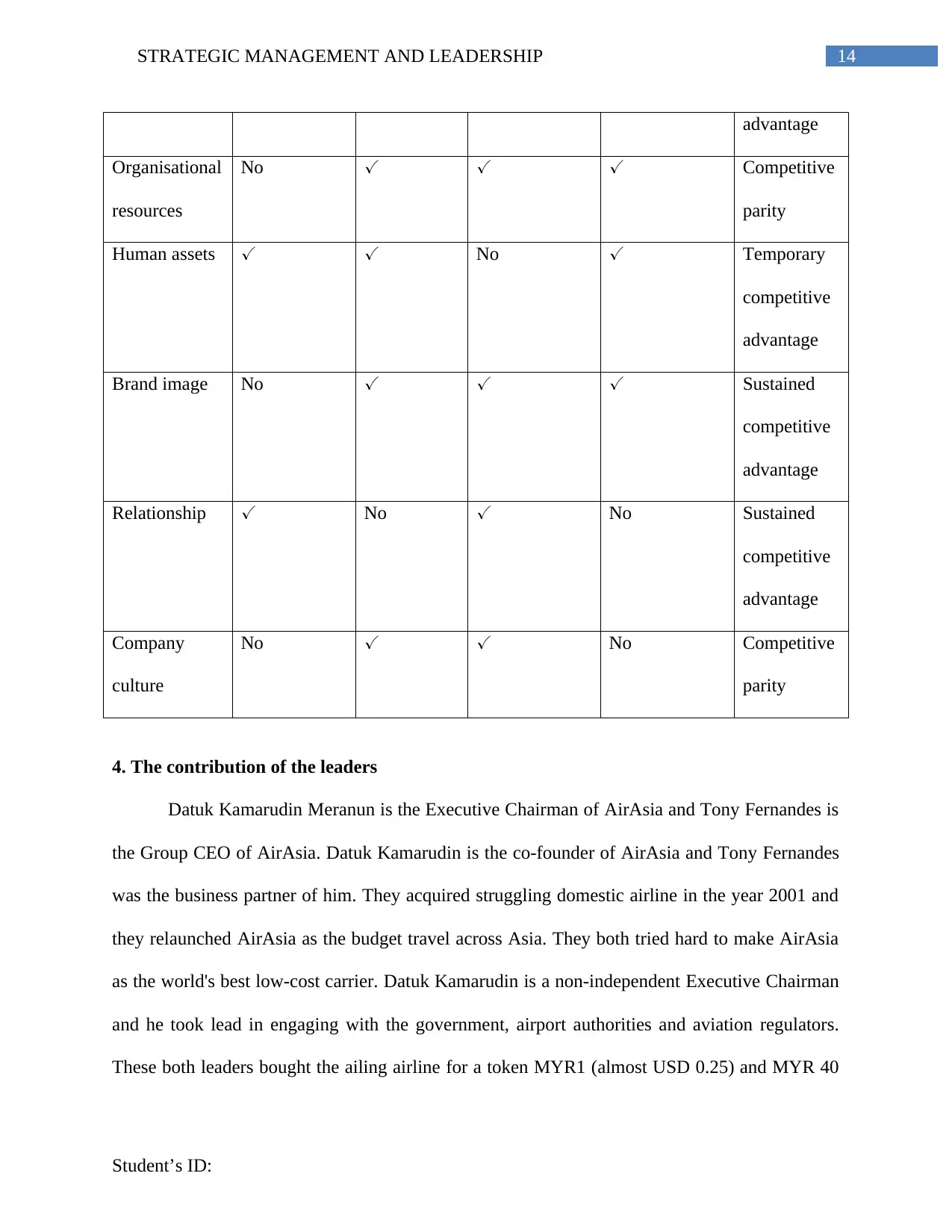
14STRATEGIC MANAGEMENT AND LEADERSHIP
advantage
Organisational
resources
No ✓ ✓ ✓ Competitive
parity
Human assets ✓ ✓ No ✓ Temporary
competitive
advantage
Brand image No ✓ ✓ ✓ Sustained
competitive
advantage
Relationship ✓ No ✓ No Sustained
competitive
advantage
Company
culture
No ✓ ✓ No Competitive
parity
4. The contribution of the leaders
Datuk Kamarudin Meranun is the Executive Chairman of AirAsia and Tony Fernandes is
the Group CEO of AirAsia. Datuk Kamarudin is the co-founder of AirAsia and Tony Fernandes
was the business partner of him. They acquired struggling domestic airline in the year 2001 and
they relaunched AirAsia as the budget travel across Asia. They both tried hard to make AirAsia
as the world's best low-cost carrier. Datuk Kamarudin is a non-independent Executive Chairman
and he took lead in engaging with the government, airport authorities and aviation regulators.
These both leaders bought the ailing airline for a token MYR1 (almost USD 0.25) and MYR 40
Student’s ID:
advantage
Organisational
resources
No ✓ ✓ ✓ Competitive
parity
Human assets ✓ ✓ No ✓ Temporary
competitive
advantage
Brand image No ✓ ✓ ✓ Sustained
competitive
advantage
Relationship ✓ No ✓ No Sustained
competitive
advantage
Company
culture
No ✓ ✓ No Competitive
parity
4. The contribution of the leaders
Datuk Kamarudin Meranun is the Executive Chairman of AirAsia and Tony Fernandes is
the Group CEO of AirAsia. Datuk Kamarudin is the co-founder of AirAsia and Tony Fernandes
was the business partner of him. They acquired struggling domestic airline in the year 2001 and
they relaunched AirAsia as the budget travel across Asia. They both tried hard to make AirAsia
as the world's best low-cost carrier. Datuk Kamarudin is a non-independent Executive Chairman
and he took lead in engaging with the government, airport authorities and aviation regulators.
These both leaders bought the ailing airline for a token MYR1 (almost USD 0.25) and MYR 40
Student’s ID:
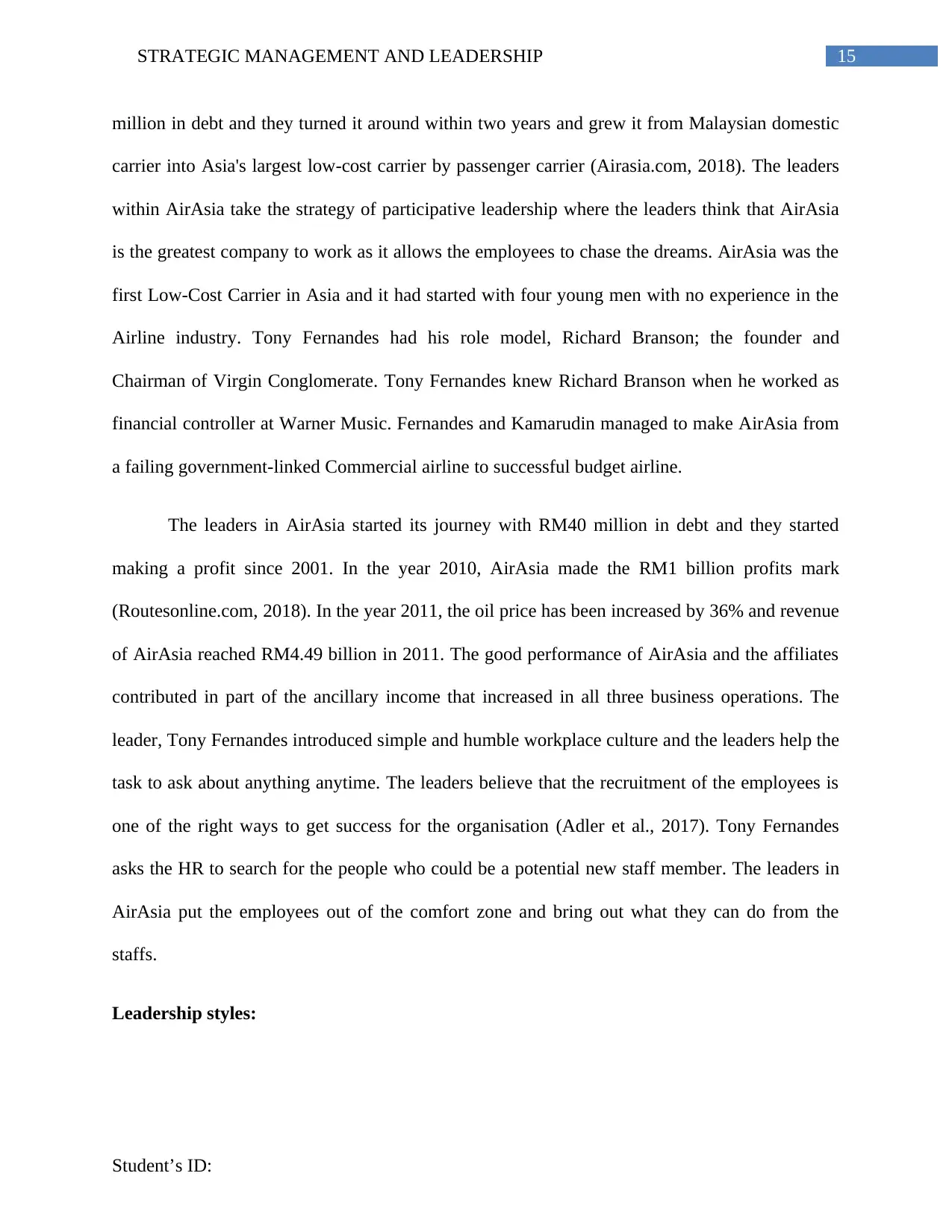
15STRATEGIC MANAGEMENT AND LEADERSHIP
million in debt and they turned it around within two years and grew it from Malaysian domestic
carrier into Asia's largest low-cost carrier by passenger carrier (Airasia.com, 2018). The leaders
within AirAsia take the strategy of participative leadership where the leaders think that AirAsia
is the greatest company to work as it allows the employees to chase the dreams. AirAsia was the
first Low-Cost Carrier in Asia and it had started with four young men with no experience in the
Airline industry. Tony Fernandes had his role model, Richard Branson; the founder and
Chairman of Virgin Conglomerate. Tony Fernandes knew Richard Branson when he worked as
financial controller at Warner Music. Fernandes and Kamarudin managed to make AirAsia from
a failing government-linked Commercial airline to successful budget airline.
The leaders in AirAsia started its journey with RM40 million in debt and they started
making a profit since 2001. In the year 2010, AirAsia made the RM1 billion profits mark
(Routesonline.com, 2018). In the year 2011, the oil price has been increased by 36% and revenue
of AirAsia reached RM4.49 billion in 2011. The good performance of AirAsia and the affiliates
contributed in part of the ancillary income that increased in all three business operations. The
leader, Tony Fernandes introduced simple and humble workplace culture and the leaders help the
task to ask about anything anytime. The leaders believe that the recruitment of the employees is
one of the right ways to get success for the organisation (Adler et al., 2017). Tony Fernandes
asks the HR to search for the people who could be a potential new staff member. The leaders in
AirAsia put the employees out of the comfort zone and bring out what they can do from the
staffs.
Leadership styles:
Student’s ID:
million in debt and they turned it around within two years and grew it from Malaysian domestic
carrier into Asia's largest low-cost carrier by passenger carrier (Airasia.com, 2018). The leaders
within AirAsia take the strategy of participative leadership where the leaders think that AirAsia
is the greatest company to work as it allows the employees to chase the dreams. AirAsia was the
first Low-Cost Carrier in Asia and it had started with four young men with no experience in the
Airline industry. Tony Fernandes had his role model, Richard Branson; the founder and
Chairman of Virgin Conglomerate. Tony Fernandes knew Richard Branson when he worked as
financial controller at Warner Music. Fernandes and Kamarudin managed to make AirAsia from
a failing government-linked Commercial airline to successful budget airline.
The leaders in AirAsia started its journey with RM40 million in debt and they started
making a profit since 2001. In the year 2010, AirAsia made the RM1 billion profits mark
(Routesonline.com, 2018). In the year 2011, the oil price has been increased by 36% and revenue
of AirAsia reached RM4.49 billion in 2011. The good performance of AirAsia and the affiliates
contributed in part of the ancillary income that increased in all three business operations. The
leader, Tony Fernandes introduced simple and humble workplace culture and the leaders help the
task to ask about anything anytime. The leaders believe that the recruitment of the employees is
one of the right ways to get success for the organisation (Adler et al., 2017). Tony Fernandes
asks the HR to search for the people who could be a potential new staff member. The leaders in
AirAsia put the employees out of the comfort zone and bring out what they can do from the
staffs.
Leadership styles:
Student’s ID:
Secure Best Marks with AI Grader
Need help grading? Try our AI Grader for instant feedback on your assignments.
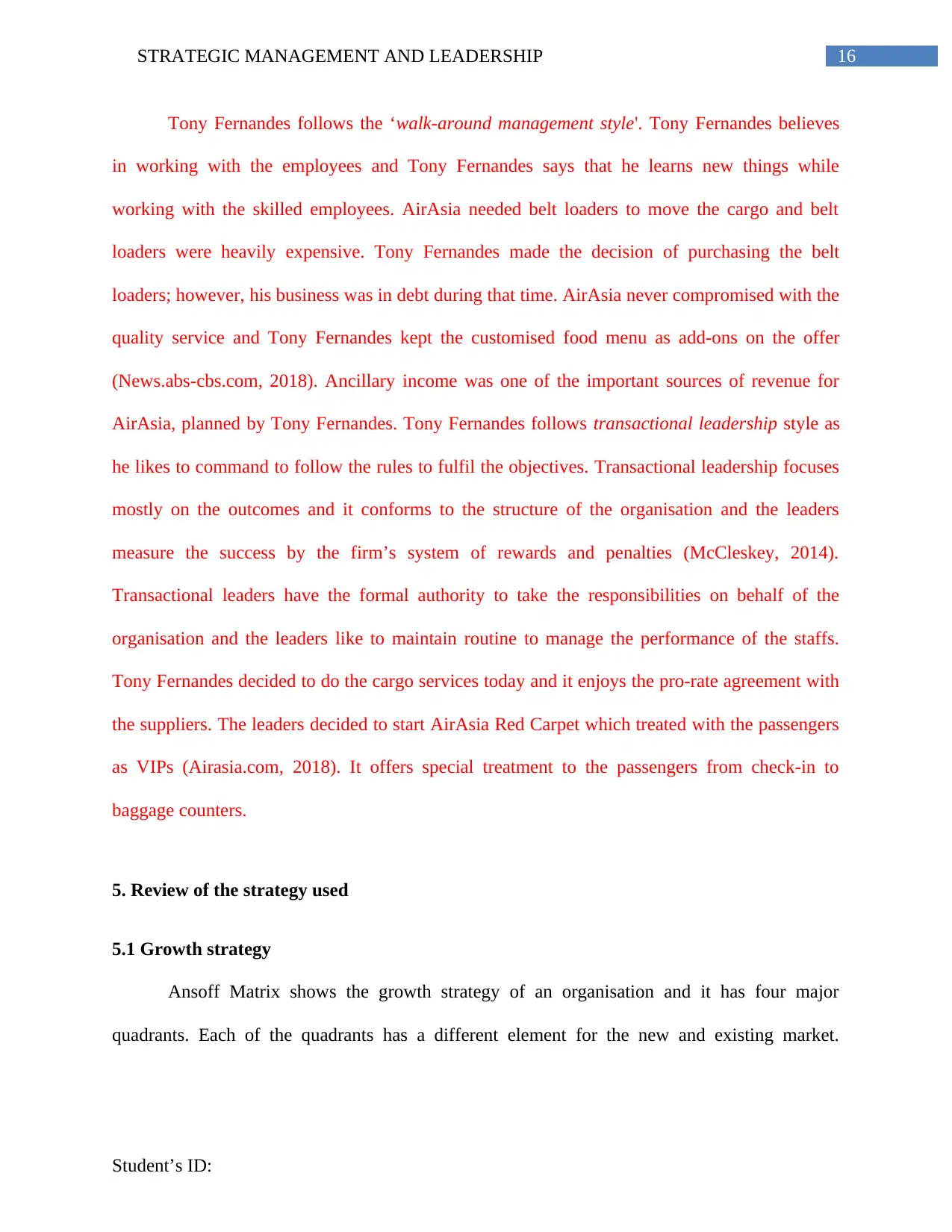
16STRATEGIC MANAGEMENT AND LEADERSHIP
Tony Fernandes follows the ‘walk-around management style'. Tony Fernandes believes
in working with the employees and Tony Fernandes says that he learns new things while
working with the skilled employees. AirAsia needed belt loaders to move the cargo and belt
loaders were heavily expensive. Tony Fernandes made the decision of purchasing the belt
loaders; however, his business was in debt during that time. AirAsia never compromised with the
quality service and Tony Fernandes kept the customised food menu as add-ons on the offer
(News.abs-cbs.com, 2018). Ancillary income was one of the important sources of revenue for
AirAsia, planned by Tony Fernandes. Tony Fernandes follows transactional leadership style as
he likes to command to follow the rules to fulfil the objectives. Transactional leadership focuses
mostly on the outcomes and it conforms to the structure of the organisation and the leaders
measure the success by the firm’s system of rewards and penalties (McCleskey, 2014).
Transactional leaders have the formal authority to take the responsibilities on behalf of the
organisation and the leaders like to maintain routine to manage the performance of the staffs.
Tony Fernandes decided to do the cargo services today and it enjoys the pro-rate agreement with
the suppliers. The leaders decided to start AirAsia Red Carpet which treated with the passengers
as VIPs (Airasia.com, 2018). It offers special treatment to the passengers from check-in to
baggage counters.
5. Review of the strategy used
5.1 Growth strategy
Ansoff Matrix shows the growth strategy of an organisation and it has four major
quadrants. Each of the quadrants has a different element for the new and existing market.
Student’s ID:
Tony Fernandes follows the ‘walk-around management style'. Tony Fernandes believes
in working with the employees and Tony Fernandes says that he learns new things while
working with the skilled employees. AirAsia needed belt loaders to move the cargo and belt
loaders were heavily expensive. Tony Fernandes made the decision of purchasing the belt
loaders; however, his business was in debt during that time. AirAsia never compromised with the
quality service and Tony Fernandes kept the customised food menu as add-ons on the offer
(News.abs-cbs.com, 2018). Ancillary income was one of the important sources of revenue for
AirAsia, planned by Tony Fernandes. Tony Fernandes follows transactional leadership style as
he likes to command to follow the rules to fulfil the objectives. Transactional leadership focuses
mostly on the outcomes and it conforms to the structure of the organisation and the leaders
measure the success by the firm’s system of rewards and penalties (McCleskey, 2014).
Transactional leaders have the formal authority to take the responsibilities on behalf of the
organisation and the leaders like to maintain routine to manage the performance of the staffs.
Tony Fernandes decided to do the cargo services today and it enjoys the pro-rate agreement with
the suppliers. The leaders decided to start AirAsia Red Carpet which treated with the passengers
as VIPs (Airasia.com, 2018). It offers special treatment to the passengers from check-in to
baggage counters.
5. Review of the strategy used
5.1 Growth strategy
Ansoff Matrix shows the growth strategy of an organisation and it has four major
quadrants. Each of the quadrants has a different element for the new and existing market.
Student’s ID:
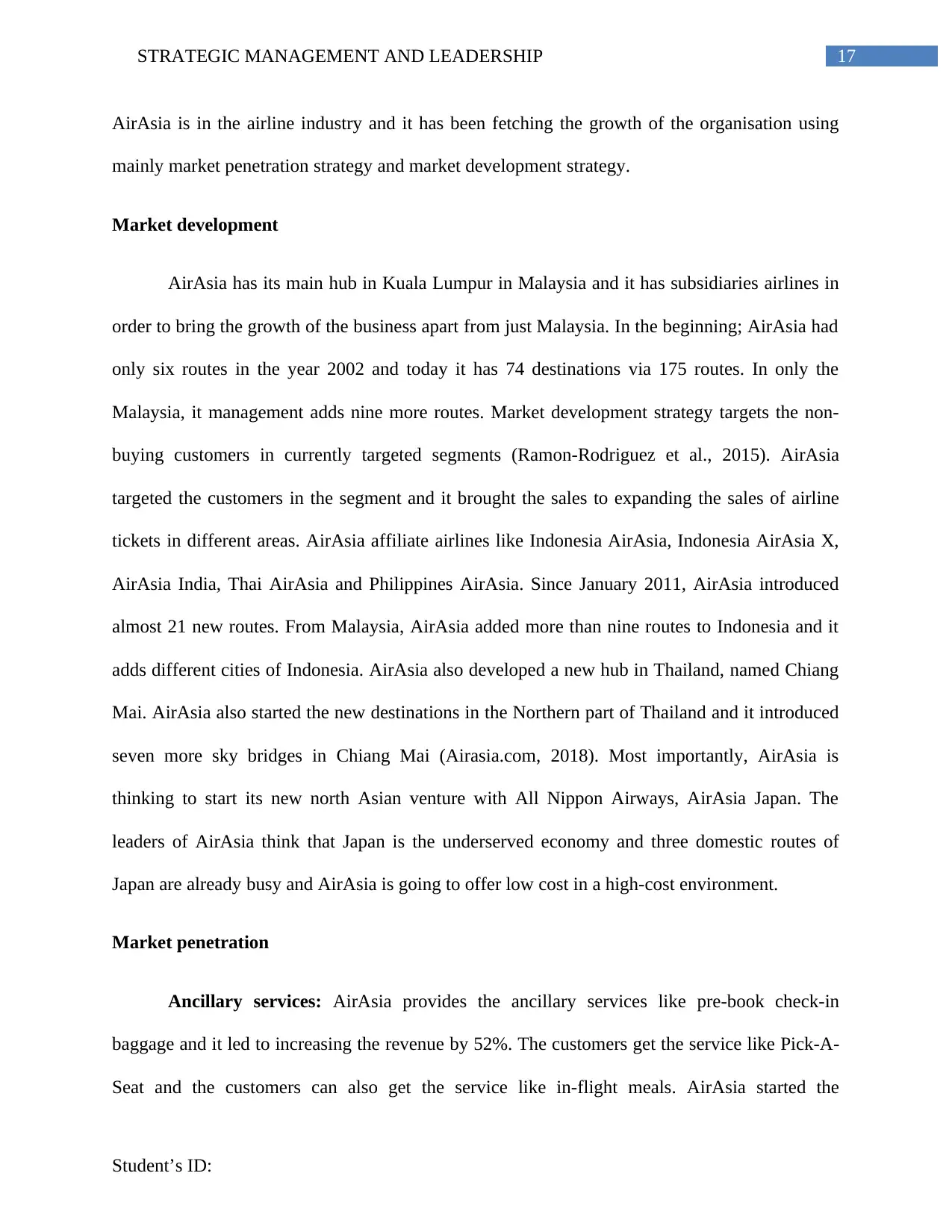
17STRATEGIC MANAGEMENT AND LEADERSHIP
AirAsia is in the airline industry and it has been fetching the growth of the organisation using
mainly market penetration strategy and market development strategy.
Market development
AirAsia has its main hub in Kuala Lumpur in Malaysia and it has subsidiaries airlines in
order to bring the growth of the business apart from just Malaysia. In the beginning; AirAsia had
only six routes in the year 2002 and today it has 74 destinations via 175 routes. In only the
Malaysia, it management adds nine more routes. Market development strategy targets the non-
buying customers in currently targeted segments (Ramon-Rodriguez et al., 2015). AirAsia
targeted the customers in the segment and it brought the sales to expanding the sales of airline
tickets in different areas. AirAsia affiliate airlines like Indonesia AirAsia, Indonesia AirAsia X,
AirAsia India, Thai AirAsia and Philippines AirAsia. Since January 2011, AirAsia introduced
almost 21 new routes. From Malaysia, AirAsia added more than nine routes to Indonesia and it
adds different cities of Indonesia. AirAsia also developed a new hub in Thailand, named Chiang
Mai. AirAsia also started the new destinations in the Northern part of Thailand and it introduced
seven more sky bridges in Chiang Mai (Airasia.com, 2018). Most importantly, AirAsia is
thinking to start its new north Asian venture with All Nippon Airways, AirAsia Japan. The
leaders of AirAsia think that Japan is the underserved economy and three domestic routes of
Japan are already busy and AirAsia is going to offer low cost in a high-cost environment.
Market penetration
Ancillary services: AirAsia provides the ancillary services like pre-book check-in
baggage and it led to increasing the revenue by 52%. The customers get the service like Pick-A-
Seat and the customers can also get the service like in-flight meals. AirAsia started the
Student’s ID:
AirAsia is in the airline industry and it has been fetching the growth of the organisation using
mainly market penetration strategy and market development strategy.
Market development
AirAsia has its main hub in Kuala Lumpur in Malaysia and it has subsidiaries airlines in
order to bring the growth of the business apart from just Malaysia. In the beginning; AirAsia had
only six routes in the year 2002 and today it has 74 destinations via 175 routes. In only the
Malaysia, it management adds nine more routes. Market development strategy targets the non-
buying customers in currently targeted segments (Ramon-Rodriguez et al., 2015). AirAsia
targeted the customers in the segment and it brought the sales to expanding the sales of airline
tickets in different areas. AirAsia affiliate airlines like Indonesia AirAsia, Indonesia AirAsia X,
AirAsia India, Thai AirAsia and Philippines AirAsia. Since January 2011, AirAsia introduced
almost 21 new routes. From Malaysia, AirAsia added more than nine routes to Indonesia and it
adds different cities of Indonesia. AirAsia also developed a new hub in Thailand, named Chiang
Mai. AirAsia also started the new destinations in the Northern part of Thailand and it introduced
seven more sky bridges in Chiang Mai (Airasia.com, 2018). Most importantly, AirAsia is
thinking to start its new north Asian venture with All Nippon Airways, AirAsia Japan. The
leaders of AirAsia think that Japan is the underserved economy and three domestic routes of
Japan are already busy and AirAsia is going to offer low cost in a high-cost environment.
Market penetration
Ancillary services: AirAsia provides the ancillary services like pre-book check-in
baggage and it led to increasing the revenue by 52%. The customers get the service like Pick-A-
Seat and the customers can also get the service like in-flight meals. AirAsia started the
Student’s ID:
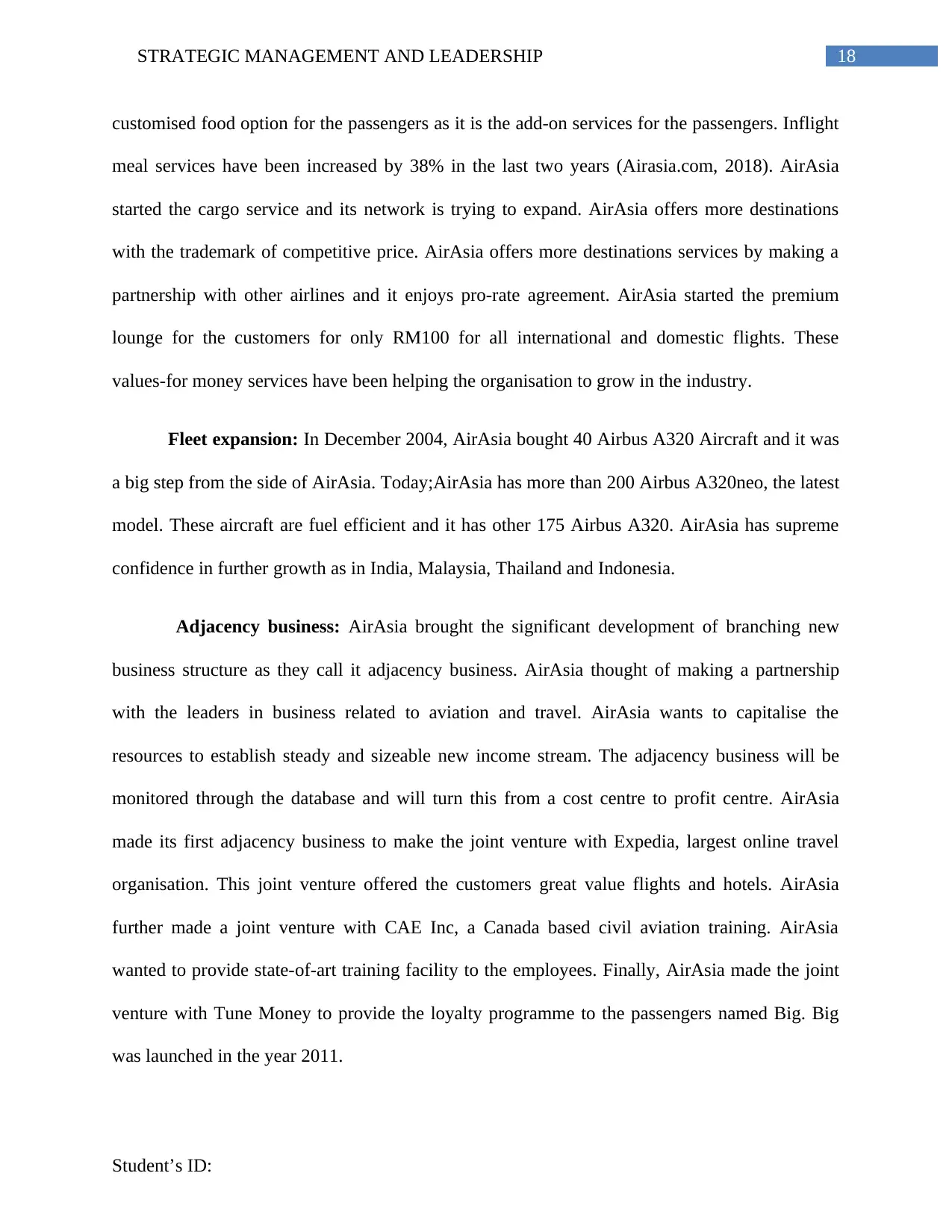
18STRATEGIC MANAGEMENT AND LEADERSHIP
customised food option for the passengers as it is the add-on services for the passengers. Inflight
meal services have been increased by 38% in the last two years (Airasia.com, 2018). AirAsia
started the cargo service and its network is trying to expand. AirAsia offers more destinations
with the trademark of competitive price. AirAsia offers more destinations services by making a
partnership with other airlines and it enjoys pro-rate agreement. AirAsia started the premium
lounge for the customers for only RM100 for all international and domestic flights. These
values-for money services have been helping the organisation to grow in the industry.
Fleet expansion: In December 2004, AirAsia bought 40 Airbus A320 Aircraft and it was
a big step from the side of AirAsia. Today;AirAsia has more than 200 Airbus A320neo, the latest
model. These aircraft are fuel efficient and it has other 175 Airbus A320. AirAsia has supreme
confidence in further growth as in India, Malaysia, Thailand and Indonesia.
Adjacency business: AirAsia brought the significant development of branching new
business structure as they call it adjacency business. AirAsia thought of making a partnership
with the leaders in business related to aviation and travel. AirAsia wants to capitalise the
resources to establish steady and sizeable new income stream. The adjacency business will be
monitored through the database and will turn this from a cost centre to profit centre. AirAsia
made its first adjacency business to make the joint venture with Expedia, largest online travel
organisation. This joint venture offered the customers great value flights and hotels. AirAsia
further made a joint venture with CAE Inc, a Canada based civil aviation training. AirAsia
wanted to provide state-of-art training facility to the employees. Finally, AirAsia made the joint
venture with Tune Money to provide the loyalty programme to the passengers named Big. Big
was launched in the year 2011.
Student’s ID:
customised food option for the passengers as it is the add-on services for the passengers. Inflight
meal services have been increased by 38% in the last two years (Airasia.com, 2018). AirAsia
started the cargo service and its network is trying to expand. AirAsia offers more destinations
with the trademark of competitive price. AirAsia offers more destinations services by making a
partnership with other airlines and it enjoys pro-rate agreement. AirAsia started the premium
lounge for the customers for only RM100 for all international and domestic flights. These
values-for money services have been helping the organisation to grow in the industry.
Fleet expansion: In December 2004, AirAsia bought 40 Airbus A320 Aircraft and it was
a big step from the side of AirAsia. Today;AirAsia has more than 200 Airbus A320neo, the latest
model. These aircraft are fuel efficient and it has other 175 Airbus A320. AirAsia has supreme
confidence in further growth as in India, Malaysia, Thailand and Indonesia.
Adjacency business: AirAsia brought the significant development of branching new
business structure as they call it adjacency business. AirAsia thought of making a partnership
with the leaders in business related to aviation and travel. AirAsia wants to capitalise the
resources to establish steady and sizeable new income stream. The adjacency business will be
monitored through the database and will turn this from a cost centre to profit centre. AirAsia
made its first adjacency business to make the joint venture with Expedia, largest online travel
organisation. This joint venture offered the customers great value flights and hotels. AirAsia
further made a joint venture with CAE Inc, a Canada based civil aviation training. AirAsia
wanted to provide state-of-art training facility to the employees. Finally, AirAsia made the joint
venture with Tune Money to provide the loyalty programme to the passengers named Big. Big
was launched in the year 2011.
Student’s ID:
Paraphrase This Document
Need a fresh take? Get an instant paraphrase of this document with our AI Paraphraser
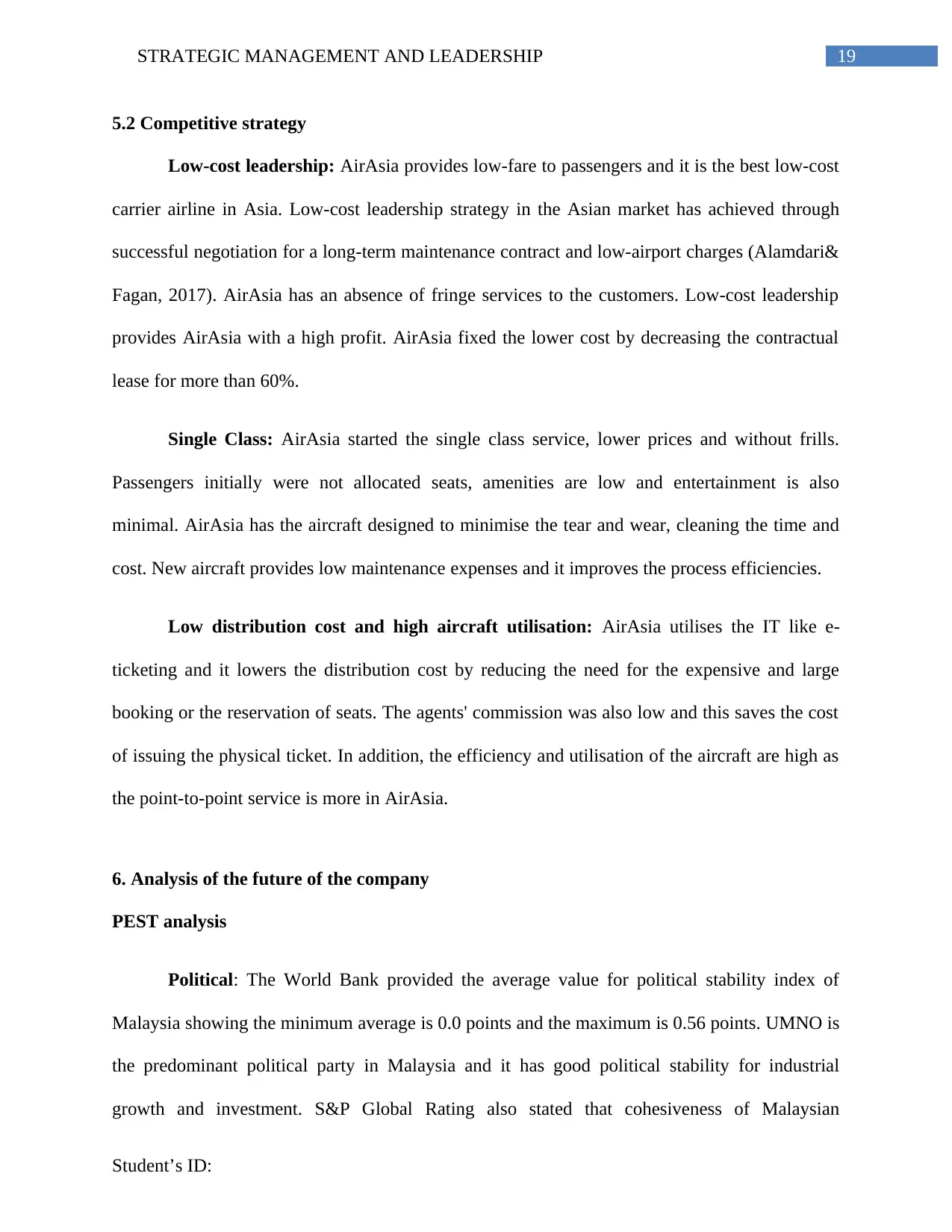
19STRATEGIC MANAGEMENT AND LEADERSHIP
5.2 Competitive strategy
Low-cost leadership: AirAsia provides low-fare to passengers and it is the best low-cost
carrier airline in Asia. Low-cost leadership strategy in the Asian market has achieved through
successful negotiation for a long-term maintenance contract and low-airport charges (Alamdari&
Fagan, 2017). AirAsia has an absence of fringe services to the customers. Low-cost leadership
provides AirAsia with a high profit. AirAsia fixed the lower cost by decreasing the contractual
lease for more than 60%.
Single Class: AirAsia started the single class service, lower prices and without frills.
Passengers initially were not allocated seats, amenities are low and entertainment is also
minimal. AirAsia has the aircraft designed to minimise the tear and wear, cleaning the time and
cost. New aircraft provides low maintenance expenses and it improves the process efficiencies.
Low distribution cost and high aircraft utilisation: AirAsia utilises the IT like e-
ticketing and it lowers the distribution cost by reducing the need for the expensive and large
booking or the reservation of seats. The agents' commission was also low and this saves the cost
of issuing the physical ticket. In addition, the efficiency and utilisation of the aircraft are high as
the point-to-point service is more in AirAsia.
6. Analysis of the future of the company
PEST analysis
Political: The World Bank provided the average value for political stability index of
Malaysia showing the minimum average is 0.0 points and the maximum is 0.56 points. UMNO is
the predominant political party in Malaysia and it has good political stability for industrial
growth and investment. S&P Global Rating also stated that cohesiveness of Malaysian
Student’s ID:
5.2 Competitive strategy
Low-cost leadership: AirAsia provides low-fare to passengers and it is the best low-cost
carrier airline in Asia. Low-cost leadership strategy in the Asian market has achieved through
successful negotiation for a long-term maintenance contract and low-airport charges (Alamdari&
Fagan, 2017). AirAsia has an absence of fringe services to the customers. Low-cost leadership
provides AirAsia with a high profit. AirAsia fixed the lower cost by decreasing the contractual
lease for more than 60%.
Single Class: AirAsia started the single class service, lower prices and without frills.
Passengers initially were not allocated seats, amenities are low and entertainment is also
minimal. AirAsia has the aircraft designed to minimise the tear and wear, cleaning the time and
cost. New aircraft provides low maintenance expenses and it improves the process efficiencies.
Low distribution cost and high aircraft utilisation: AirAsia utilises the IT like e-
ticketing and it lowers the distribution cost by reducing the need for the expensive and large
booking or the reservation of seats. The agents' commission was also low and this saves the cost
of issuing the physical ticket. In addition, the efficiency and utilisation of the aircraft are high as
the point-to-point service is more in AirAsia.
6. Analysis of the future of the company
PEST analysis
Political: The World Bank provided the average value for political stability index of
Malaysia showing the minimum average is 0.0 points and the maximum is 0.56 points. UMNO is
the predominant political party in Malaysia and it has good political stability for industrial
growth and investment. S&P Global Rating also stated that cohesiveness of Malaysian
Student’s ID:
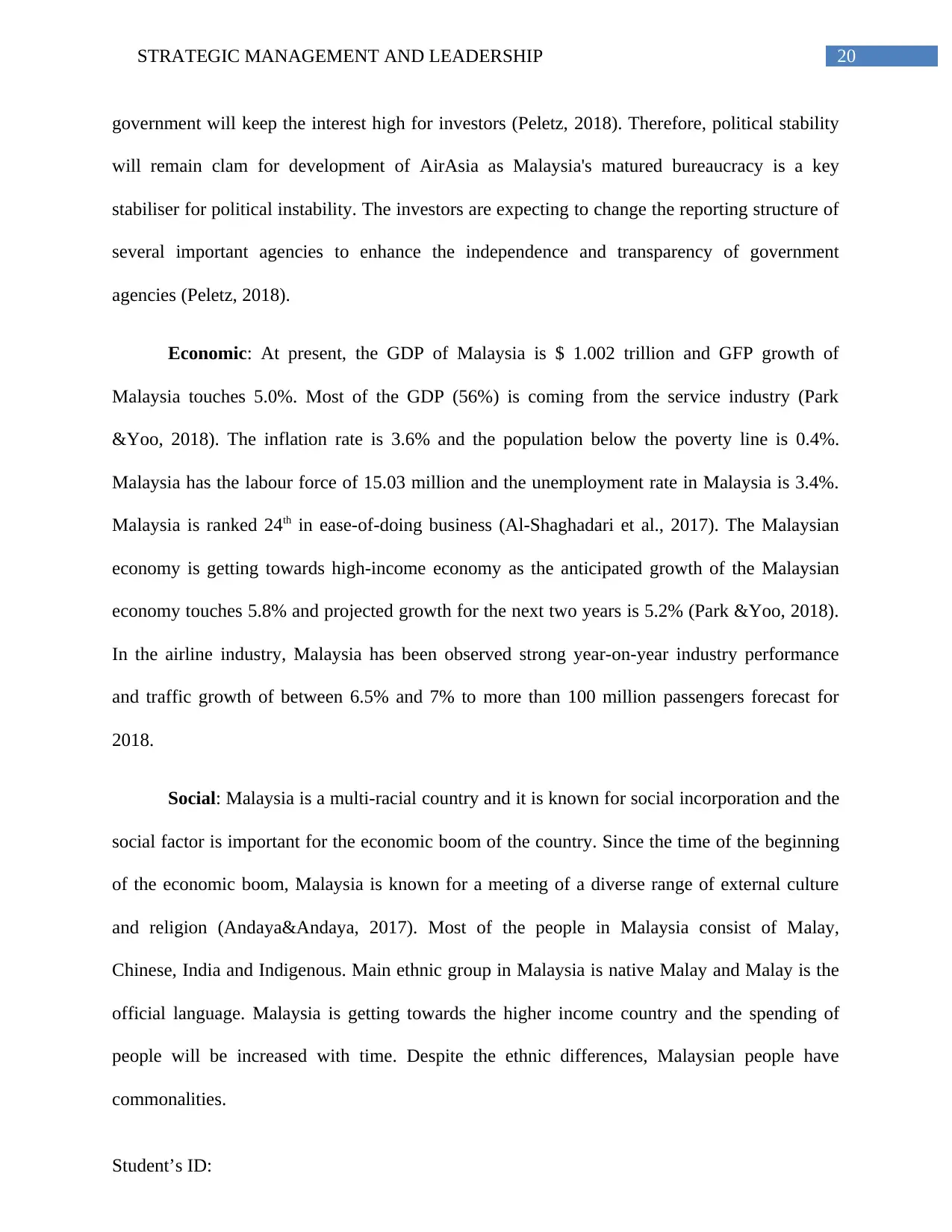
20STRATEGIC MANAGEMENT AND LEADERSHIP
government will keep the interest high for investors (Peletz, 2018). Therefore, political stability
will remain clam for development of AirAsia as Malaysia's matured bureaucracy is a key
stabiliser for political instability. The investors are expecting to change the reporting structure of
several important agencies to enhance the independence and transparency of government
agencies (Peletz, 2018).
Economic: At present, the GDP of Malaysia is $ 1.002 trillion and GFP growth of
Malaysia touches 5.0%. Most of the GDP (56%) is coming from the service industry (Park
&Yoo, 2018). The inflation rate is 3.6% and the population below the poverty line is 0.4%.
Malaysia has the labour force of 15.03 million and the unemployment rate in Malaysia is 3.4%.
Malaysia is ranked 24th in ease-of-doing business (Al-Shaghadari et al., 2017). The Malaysian
economy is getting towards high-income economy as the anticipated growth of the Malaysian
economy touches 5.8% and projected growth for the next two years is 5.2% (Park &Yoo, 2018).
In the airline industry, Malaysia has been observed strong year-on-year industry performance
and traffic growth of between 6.5% and 7% to more than 100 million passengers forecast for
2018.
Social: Malaysia is a multi-racial country and it is known for social incorporation and the
social factor is important for the economic boom of the country. Since the time of the beginning
of the economic boom, Malaysia is known for a meeting of a diverse range of external culture
and religion (Andaya&Andaya, 2017). Most of the people in Malaysia consist of Malay,
Chinese, India and Indigenous. Main ethnic group in Malaysia is native Malay and Malay is the
official language. Malaysia is getting towards the higher income country and the spending of
people will be increased with time. Despite the ethnic differences, Malaysian people have
commonalities.
Student’s ID:
government will keep the interest high for investors (Peletz, 2018). Therefore, political stability
will remain clam for development of AirAsia as Malaysia's matured bureaucracy is a key
stabiliser for political instability. The investors are expecting to change the reporting structure of
several important agencies to enhance the independence and transparency of government
agencies (Peletz, 2018).
Economic: At present, the GDP of Malaysia is $ 1.002 trillion and GFP growth of
Malaysia touches 5.0%. Most of the GDP (56%) is coming from the service industry (Park
&Yoo, 2018). The inflation rate is 3.6% and the population below the poverty line is 0.4%.
Malaysia has the labour force of 15.03 million and the unemployment rate in Malaysia is 3.4%.
Malaysia is ranked 24th in ease-of-doing business (Al-Shaghadari et al., 2017). The Malaysian
economy is getting towards high-income economy as the anticipated growth of the Malaysian
economy touches 5.8% and projected growth for the next two years is 5.2% (Park &Yoo, 2018).
In the airline industry, Malaysia has been observed strong year-on-year industry performance
and traffic growth of between 6.5% and 7% to more than 100 million passengers forecast for
2018.
Social: Malaysia is a multi-racial country and it is known for social incorporation and the
social factor is important for the economic boom of the country. Since the time of the beginning
of the economic boom, Malaysia is known for a meeting of a diverse range of external culture
and religion (Andaya&Andaya, 2017). Most of the people in Malaysia consist of Malay,
Chinese, India and Indigenous. Main ethnic group in Malaysia is native Malay and Malay is the
official language. Malaysia is getting towards the higher income country and the spending of
people will be increased with time. Despite the ethnic differences, Malaysian people have
commonalities.
Student’s ID:
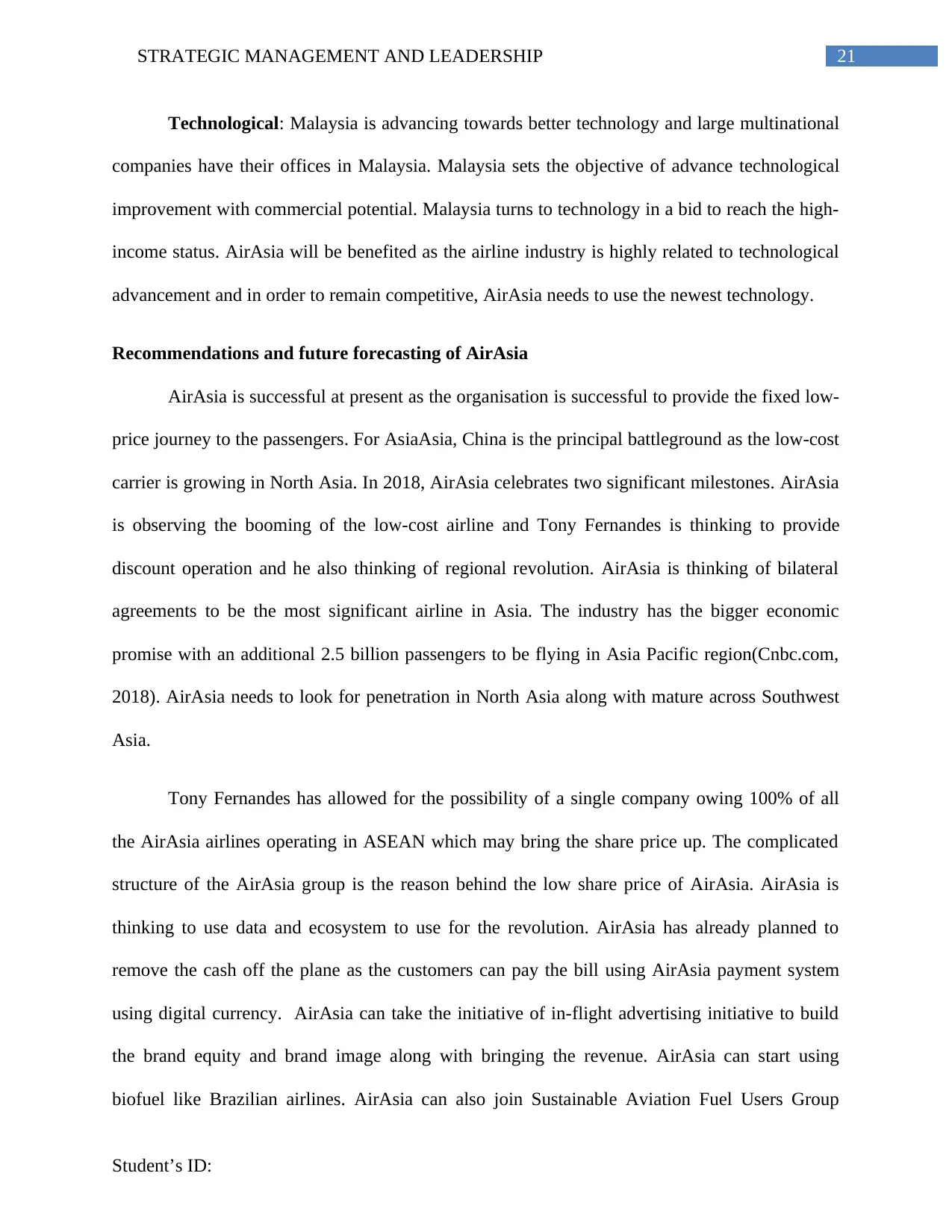
21STRATEGIC MANAGEMENT AND LEADERSHIP
Technological: Malaysia is advancing towards better technology and large multinational
companies have their offices in Malaysia. Malaysia sets the objective of advance technological
improvement with commercial potential. Malaysia turns to technology in a bid to reach the high-
income status. AirAsia will be benefited as the airline industry is highly related to technological
advancement and in order to remain competitive, AirAsia needs to use the newest technology.
Recommendations and future forecasting of AirAsia
AirAsia is successful at present as the organisation is successful to provide the fixed low-
price journey to the passengers. For AsiaAsia, China is the principal battleground as the low-cost
carrier is growing in North Asia. In 2018, AirAsia celebrates two significant milestones. AirAsia
is observing the booming of the low-cost airline and Tony Fernandes is thinking to provide
discount operation and he also thinking of regional revolution. AirAsia is thinking of bilateral
agreements to be the most significant airline in Asia. The industry has the bigger economic
promise with an additional 2.5 billion passengers to be flying in Asia Pacific region(Cnbc.com,
2018). AirAsia needs to look for penetration in North Asia along with mature across Southwest
Asia.
Tony Fernandes has allowed for the possibility of a single company owing 100% of all
the AirAsia airlines operating in ASEAN which may bring the share price up. The complicated
structure of the AirAsia group is the reason behind the low share price of AirAsia. AirAsia is
thinking to use data and ecosystem to use for the revolution. AirAsia has already planned to
remove the cash off the plane as the customers can pay the bill using AirAsia payment system
using digital currency. AirAsia can take the initiative of in-flight advertising initiative to build
the brand equity and brand image along with bringing the revenue. AirAsia can start using
biofuel like Brazilian airlines. AirAsia can also join Sustainable Aviation Fuel Users Group
Student’s ID:
Technological: Malaysia is advancing towards better technology and large multinational
companies have their offices in Malaysia. Malaysia sets the objective of advance technological
improvement with commercial potential. Malaysia turns to technology in a bid to reach the high-
income status. AirAsia will be benefited as the airline industry is highly related to technological
advancement and in order to remain competitive, AirAsia needs to use the newest technology.
Recommendations and future forecasting of AirAsia
AirAsia is successful at present as the organisation is successful to provide the fixed low-
price journey to the passengers. For AsiaAsia, China is the principal battleground as the low-cost
carrier is growing in North Asia. In 2018, AirAsia celebrates two significant milestones. AirAsia
is observing the booming of the low-cost airline and Tony Fernandes is thinking to provide
discount operation and he also thinking of regional revolution. AirAsia is thinking of bilateral
agreements to be the most significant airline in Asia. The industry has the bigger economic
promise with an additional 2.5 billion passengers to be flying in Asia Pacific region(Cnbc.com,
2018). AirAsia needs to look for penetration in North Asia along with mature across Southwest
Asia.
Tony Fernandes has allowed for the possibility of a single company owing 100% of all
the AirAsia airlines operating in ASEAN which may bring the share price up. The complicated
structure of the AirAsia group is the reason behind the low share price of AirAsia. AirAsia is
thinking to use data and ecosystem to use for the revolution. AirAsia has already planned to
remove the cash off the plane as the customers can pay the bill using AirAsia payment system
using digital currency. AirAsia can take the initiative of in-flight advertising initiative to build
the brand equity and brand image along with bringing the revenue. AirAsia can start using
biofuel like Brazilian airlines. AirAsia can also join Sustainable Aviation Fuel Users Group
Student’s ID:
Secure Best Marks with AI Grader
Need help grading? Try our AI Grader for instant feedback on your assignments.
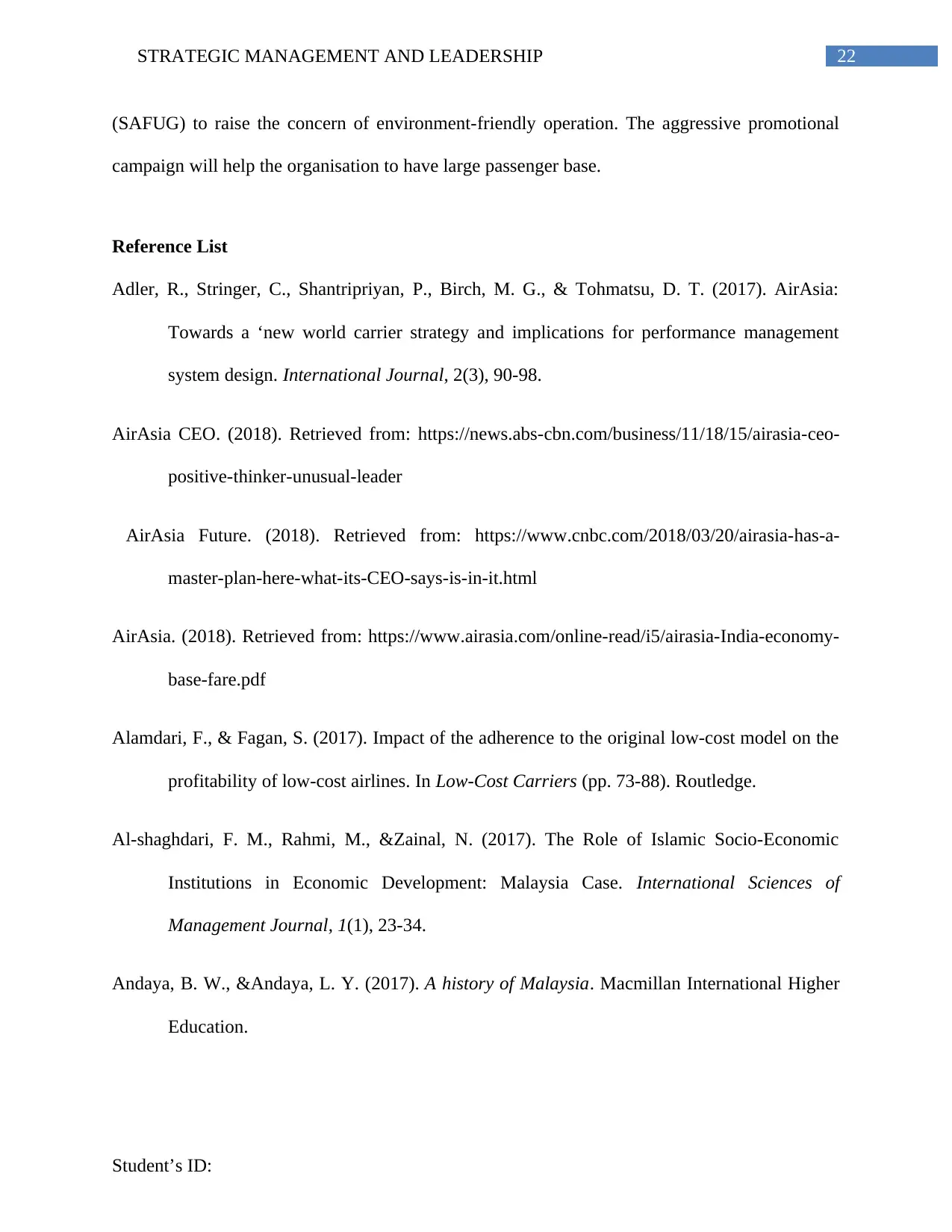
22STRATEGIC MANAGEMENT AND LEADERSHIP
(SAFUG) to raise the concern of environment-friendly operation. The aggressive promotional
campaign will help the organisation to have large passenger base.
Reference List
Adler, R., Stringer, C., Shantripriyan, P., Birch, M. G., & Tohmatsu, D. T. (2017). AirAsia:
Towards a ‘new world carrier strategy and implications for performance management
system design. International Journal, 2(3), 90-98.
AirAsia CEO. (2018). Retrieved from: https://news.abs-cbn.com/business/11/18/15/airasia-ceo-
positive-thinker-unusual-leader
AirAsia Future. (2018). Retrieved from: https://www.cnbc.com/2018/03/20/airasia-has-a-
master-plan-here-what-its-CEO-says-is-in-it.html
AirAsia. (2018). Retrieved from: https://www.airasia.com/online-read/i5/airasia-India-economy-
base-fare.pdf
Alamdari, F., & Fagan, S. (2017). Impact of the adherence to the original low-cost model on the
profitability of low-cost airlines. In Low-Cost Carriers (pp. 73-88). Routledge.
Al-shaghdari, F. M., Rahmi, M., &Zainal, N. (2017). The Role of Islamic Socio-Economic
Institutions in Economic Development: Malaysia Case. International Sciences of
Management Journal, 1(1), 23-34.
Andaya, B. W., &Andaya, L. Y. (2017). A history of Malaysia. Macmillan International Higher
Education.
Student’s ID:
(SAFUG) to raise the concern of environment-friendly operation. The aggressive promotional
campaign will help the organisation to have large passenger base.
Reference List
Adler, R., Stringer, C., Shantripriyan, P., Birch, M. G., & Tohmatsu, D. T. (2017). AirAsia:
Towards a ‘new world carrier strategy and implications for performance management
system design. International Journal, 2(3), 90-98.
AirAsia CEO. (2018). Retrieved from: https://news.abs-cbn.com/business/11/18/15/airasia-ceo-
positive-thinker-unusual-leader
AirAsia Future. (2018). Retrieved from: https://www.cnbc.com/2018/03/20/airasia-has-a-
master-plan-here-what-its-CEO-says-is-in-it.html
AirAsia. (2018). Retrieved from: https://www.airasia.com/online-read/i5/airasia-India-economy-
base-fare.pdf
Alamdari, F., & Fagan, S. (2017). Impact of the adherence to the original low-cost model on the
profitability of low-cost airlines. In Low-Cost Carriers (pp. 73-88). Routledge.
Al-shaghdari, F. M., Rahmi, M., &Zainal, N. (2017). The Role of Islamic Socio-Economic
Institutions in Economic Development: Malaysia Case. International Sciences of
Management Journal, 1(1), 23-34.
Andaya, B. W., &Andaya, L. Y. (2017). A history of Malaysia. Macmillan International Higher
Education.
Student’s ID:
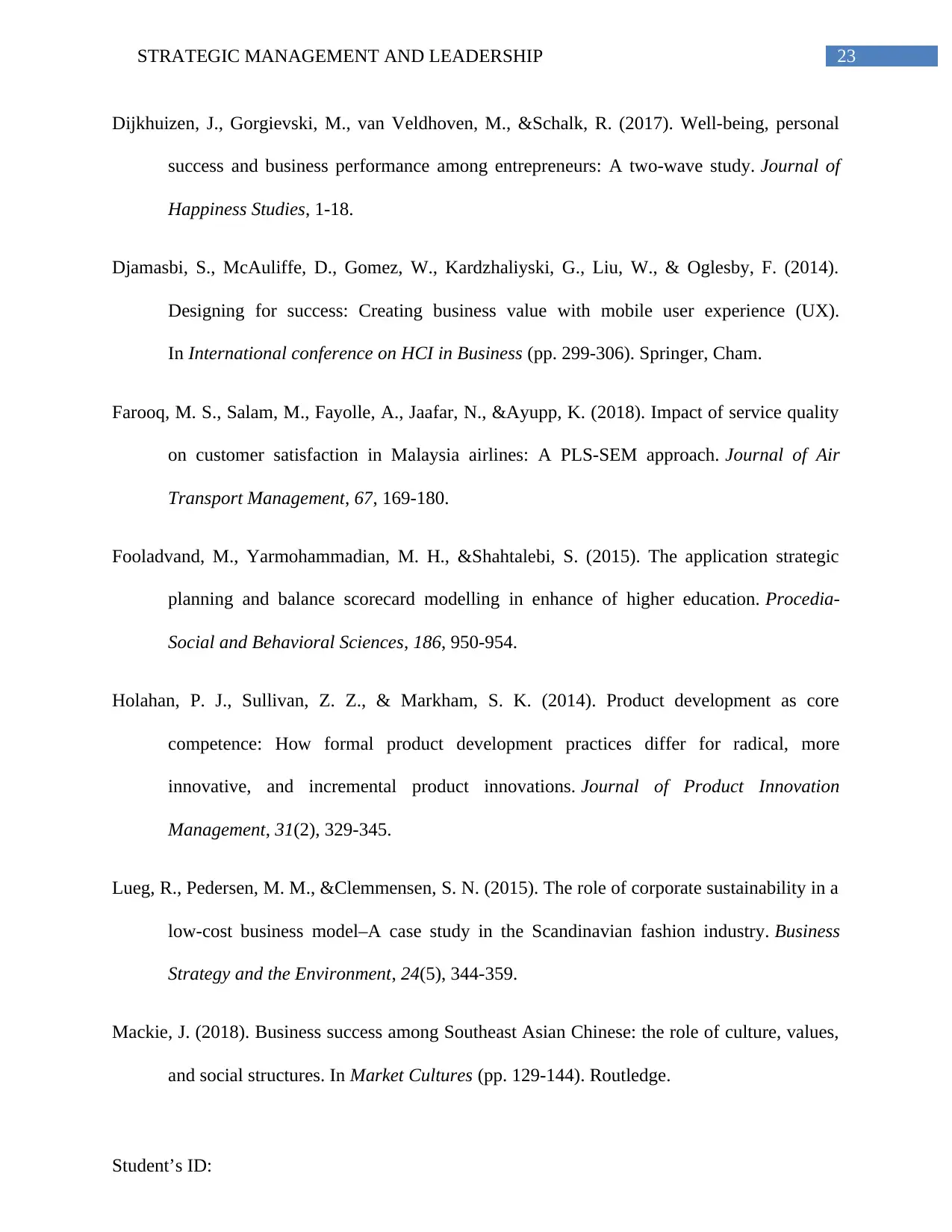
23STRATEGIC MANAGEMENT AND LEADERSHIP
Dijkhuizen, J., Gorgievski, M., van Veldhoven, M., &Schalk, R. (2017). Well-being, personal
success and business performance among entrepreneurs: A two-wave study. Journal of
Happiness Studies, 1-18.
Djamasbi, S., McAuliffe, D., Gomez, W., Kardzhaliyski, G., Liu, W., & Oglesby, F. (2014).
Designing for success: Creating business value with mobile user experience (UX).
In International conference on HCI in Business (pp. 299-306). Springer, Cham.
Farooq, M. S., Salam, M., Fayolle, A., Jaafar, N., &Ayupp, K. (2018). Impact of service quality
on customer satisfaction in Malaysia airlines: A PLS-SEM approach. Journal of Air
Transport Management, 67, 169-180.
Fooladvand, M., Yarmohammadian, M. H., &Shahtalebi, S. (2015). The application strategic
planning and balance scorecard modelling in enhance of higher education. Procedia-
Social and Behavioral Sciences, 186, 950-954.
Holahan, P. J., Sullivan, Z. Z., & Markham, S. K. (2014). Product development as core
competence: How formal product development practices differ for radical, more
innovative, and incremental product innovations. Journal of Product Innovation
Management, 31(2), 329-345.
Lueg, R., Pedersen, M. M., &Clemmensen, S. N. (2015). The role of corporate sustainability in a
low‐cost business model–A case study in the Scandinavian fashion industry. Business
Strategy and the Environment, 24(5), 344-359.
Mackie, J. (2018). Business success among Southeast Asian Chinese: the role of culture, values,
and social structures. In Market Cultures (pp. 129-144). Routledge.
Student’s ID:
Dijkhuizen, J., Gorgievski, M., van Veldhoven, M., &Schalk, R. (2017). Well-being, personal
success and business performance among entrepreneurs: A two-wave study. Journal of
Happiness Studies, 1-18.
Djamasbi, S., McAuliffe, D., Gomez, W., Kardzhaliyski, G., Liu, W., & Oglesby, F. (2014).
Designing for success: Creating business value with mobile user experience (UX).
In International conference on HCI in Business (pp. 299-306). Springer, Cham.
Farooq, M. S., Salam, M., Fayolle, A., Jaafar, N., &Ayupp, K. (2018). Impact of service quality
on customer satisfaction in Malaysia airlines: A PLS-SEM approach. Journal of Air
Transport Management, 67, 169-180.
Fooladvand, M., Yarmohammadian, M. H., &Shahtalebi, S. (2015). The application strategic
planning and balance scorecard modelling in enhance of higher education. Procedia-
Social and Behavioral Sciences, 186, 950-954.
Holahan, P. J., Sullivan, Z. Z., & Markham, S. K. (2014). Product development as core
competence: How formal product development practices differ for radical, more
innovative, and incremental product innovations. Journal of Product Innovation
Management, 31(2), 329-345.
Lueg, R., Pedersen, M. M., &Clemmensen, S. N. (2015). The role of corporate sustainability in a
low‐cost business model–A case study in the Scandinavian fashion industry. Business
Strategy and the Environment, 24(5), 344-359.
Mackie, J. (2018). Business success among Southeast Asian Chinese: the role of culture, values,
and social structures. In Market Cultures (pp. 129-144). Routledge.
Student’s ID:
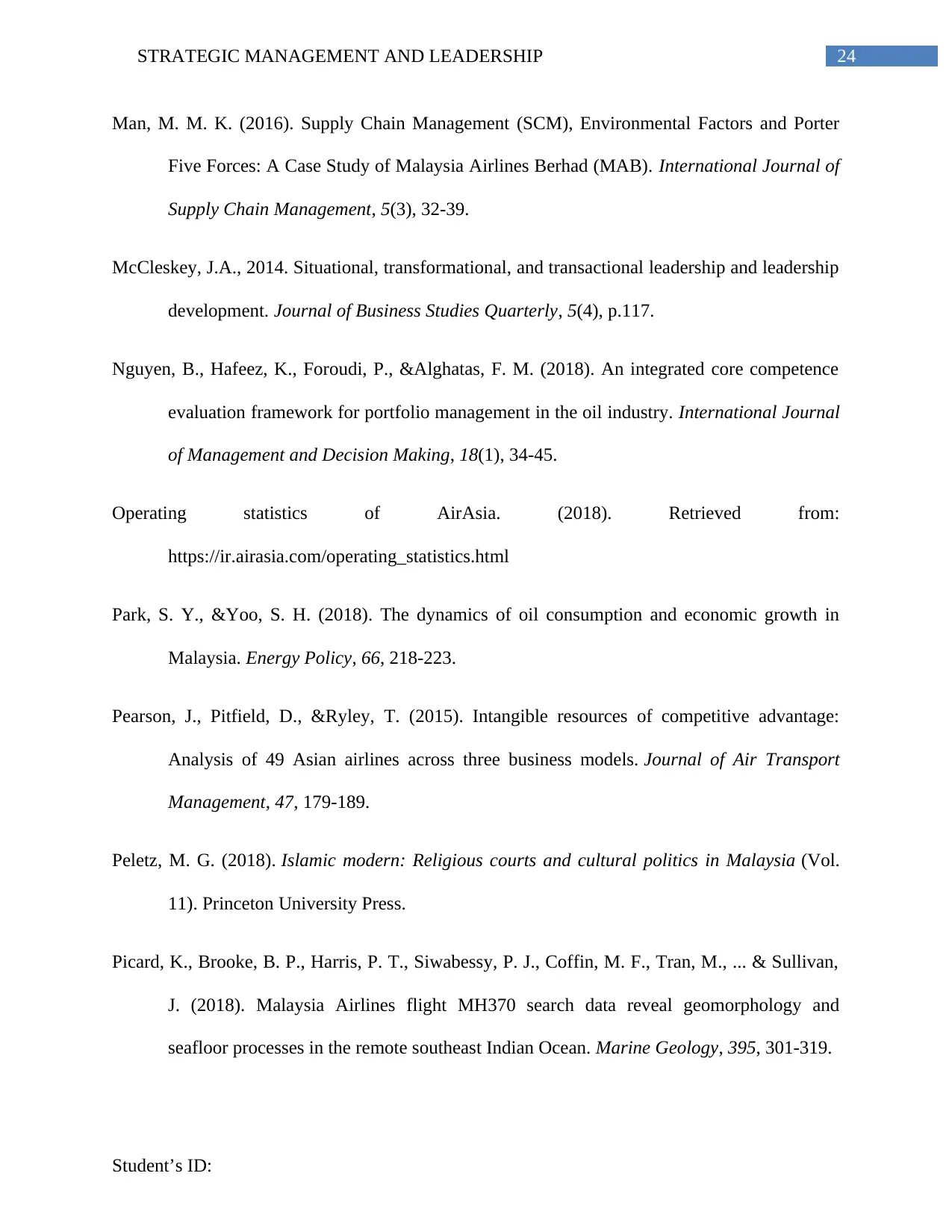
24STRATEGIC MANAGEMENT AND LEADERSHIP
Man, M. M. K. (2016). Supply Chain Management (SCM), Environmental Factors and Porter
Five Forces: A Case Study of Malaysia Airlines Berhad (MAB). International Journal of
Supply Chain Management, 5(3), 32-39.
McCleskey, J.A., 2014. Situational, transformational, and transactional leadership and leadership
development. Journal of Business Studies Quarterly, 5(4), p.117.
Nguyen, B., Hafeez, K., Foroudi, P., &Alghatas, F. M. (2018). An integrated core competence
evaluation framework for portfolio management in the oil industry. International Journal
of Management and Decision Making, 18(1), 34-45.
Operating statistics of AirAsia. (2018). Retrieved from:
https://ir.airasia.com/operating_statistics.html
Park, S. Y., &Yoo, S. H. (2018). The dynamics of oil consumption and economic growth in
Malaysia. Energy Policy, 66, 218-223.
Pearson, J., Pitfield, D., &Ryley, T. (2015). Intangible resources of competitive advantage:
Analysis of 49 Asian airlines across three business models. Journal of Air Transport
Management, 47, 179-189.
Peletz, M. G. (2018). Islamic modern: Religious courts and cultural politics in Malaysia (Vol.
11). Princeton University Press.
Picard, K., Brooke, B. P., Harris, P. T., Siwabessy, P. J., Coffin, M. F., Tran, M., ... & Sullivan,
J. (2018). Malaysia Airlines flight MH370 search data reveal geomorphology and
seafloor processes in the remote southeast Indian Ocean. Marine Geology, 395, 301-319.
Student’s ID:
Man, M. M. K. (2016). Supply Chain Management (SCM), Environmental Factors and Porter
Five Forces: A Case Study of Malaysia Airlines Berhad (MAB). International Journal of
Supply Chain Management, 5(3), 32-39.
McCleskey, J.A., 2014. Situational, transformational, and transactional leadership and leadership
development. Journal of Business Studies Quarterly, 5(4), p.117.
Nguyen, B., Hafeez, K., Foroudi, P., &Alghatas, F. M. (2018). An integrated core competence
evaluation framework for portfolio management in the oil industry. International Journal
of Management and Decision Making, 18(1), 34-45.
Operating statistics of AirAsia. (2018). Retrieved from:
https://ir.airasia.com/operating_statistics.html
Park, S. Y., &Yoo, S. H. (2018). The dynamics of oil consumption and economic growth in
Malaysia. Energy Policy, 66, 218-223.
Pearson, J., Pitfield, D., &Ryley, T. (2015). Intangible resources of competitive advantage:
Analysis of 49 Asian airlines across three business models. Journal of Air Transport
Management, 47, 179-189.
Peletz, M. G. (2018). Islamic modern: Religious courts and cultural politics in Malaysia (Vol.
11). Princeton University Press.
Picard, K., Brooke, B. P., Harris, P. T., Siwabessy, P. J., Coffin, M. F., Tran, M., ... & Sullivan,
J. (2018). Malaysia Airlines flight MH370 search data reveal geomorphology and
seafloor processes in the remote southeast Indian Ocean. Marine Geology, 395, 301-319.
Student’s ID:
Paraphrase This Document
Need a fresh take? Get an instant paraphrase of this document with our AI Paraphraser
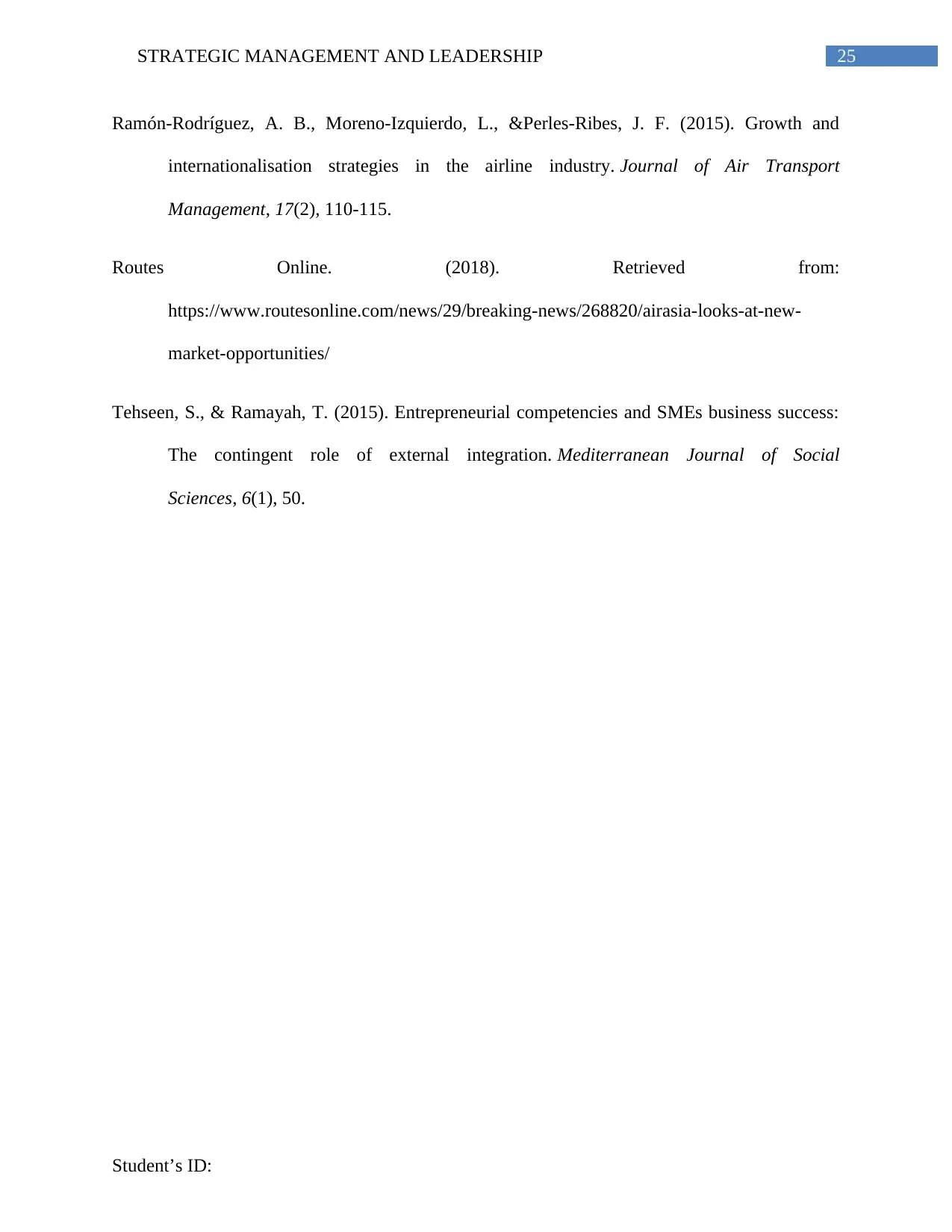
25STRATEGIC MANAGEMENT AND LEADERSHIP
Ramón-Rodríguez, A. B., Moreno-Izquierdo, L., &Perles-Ribes, J. F. (2015). Growth and
internationalisation strategies in the airline industry. Journal of Air Transport
Management, 17(2), 110-115.
Routes Online. (2018). Retrieved from:
https://www.routesonline.com/news/29/breaking-news/268820/airasia-looks-at-new-
market-opportunities/
Tehseen, S., & Ramayah, T. (2015). Entrepreneurial competencies and SMEs business success:
The contingent role of external integration. Mediterranean Journal of Social
Sciences, 6(1), 50.
Student’s ID:
Ramón-Rodríguez, A. B., Moreno-Izquierdo, L., &Perles-Ribes, J. F. (2015). Growth and
internationalisation strategies in the airline industry. Journal of Air Transport
Management, 17(2), 110-115.
Routes Online. (2018). Retrieved from:
https://www.routesonline.com/news/29/breaking-news/268820/airasia-looks-at-new-
market-opportunities/
Tehseen, S., & Ramayah, T. (2015). Entrepreneurial competencies and SMEs business success:
The contingent role of external integration. Mediterranean Journal of Social
Sciences, 6(1), 50.
Student’s ID:
1 out of 26
Related Documents
Your All-in-One AI-Powered Toolkit for Academic Success.
+13062052269
info@desklib.com
Available 24*7 on WhatsApp / Email
![[object Object]](/_next/static/media/star-bottom.7253800d.svg)
Unlock your academic potential
© 2024 | Zucol Services PVT LTD | All rights reserved.





